
-
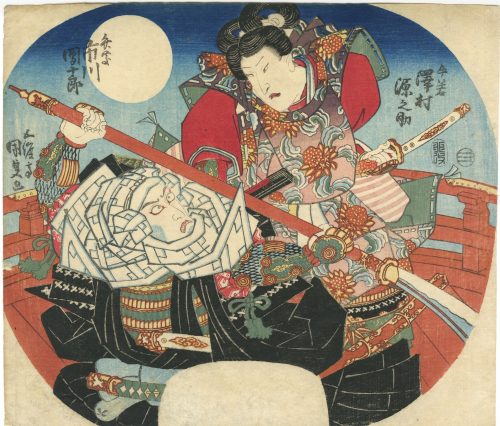 Sawamura Gennosuke II [沢村源之助] (Suketakaya Takasuke III, Sawamura Chōjūrō V, Sawamura Sōjūrō V, Sawamura Tosshō I, Sawamura Genpei I, Japanese, 1802/7 – 1853) as Ushiwakamaru [牛若丸], a.k.a. Minamoto no Yoshitsune [源 義経]. Ichikawa Danjūrō VII [市川団十郎] (Ichikawa Ebizō V, Ichikawa Hakuen II, Ichikawa Shinnosuke I, Japanese, 1791 – 1859) as Benkei, a.k.a. Saitō Musashibō Benkei [西塔武蔵坊弁慶] (Japanese, 1155 – 1189) Performance: Grand finale dance play [大切所作事] (ōgiri shosagoto) at Soga Festival - A Composite Piece of Musashi「曽我祭武蔵摂物 ごさいれいむさしのひきもの)」 (Gosairei Musashi no hikimono), performed at Kawarazakiza (河原崎座) in 05/1831 (See kabuki plays from 1831). Soga Festival (Soga Matsuri) is an annual theatre event in Edo (Tokyo). Scene: The Fight on Gojo Bridge or Benkei on the Bridge [橋弁慶] (Hashi Benkei). The story relates how Benkei, first a monk, then a mountain ascetic, and then a rogue warrior, a man of Herculean strength, was subdued by the young Onzoshi Ushiwaka Maru (Yoshitsune) on Gojo Bridge. Benkei wandered around Kyoto with the intention of relieving 1000 samurai of their swords. One night, with one more sword to go, he saw Yoshitsune playing the flute and wearing a golden sword at the Gojotenjin Shrine. They agreed to fight on Gojo Bridge in southern Kyoto. However, Yoshitsune was too agile for Benkei and had been educated in the secrets of fighting by the tengu. Following Yoshitsune’s victory, Benkei became Yoshitsune’s retainer. Artist: Utagawa Kunisada [歌川 国貞], a.k.a. Toyokuni III (Japanese, 1786 – 1865). Publisher: Ibaya Senzaburo [伊場屋仙三郎]. Signed: Gototei Kunisada ga [五渡亭国貞画]. Date-aratame seal: Tenpō 2 (1831). Size: Fan print (uchiwa-e). Ref.: (1) Tokyo Metropolitan Library, 請求記号 M339-6/東M339-006. (2) Ritsumeikan University, Art Research Center, Portal Database M339-006(02).
Sawamura Gennosuke II [沢村源之助] (Suketakaya Takasuke III, Sawamura Chōjūrō V, Sawamura Sōjūrō V, Sawamura Tosshō I, Sawamura Genpei I, Japanese, 1802/7 – 1853) as Ushiwakamaru [牛若丸], a.k.a. Minamoto no Yoshitsune [源 義経]. Ichikawa Danjūrō VII [市川団十郎] (Ichikawa Ebizō V, Ichikawa Hakuen II, Ichikawa Shinnosuke I, Japanese, 1791 – 1859) as Benkei, a.k.a. Saitō Musashibō Benkei [西塔武蔵坊弁慶] (Japanese, 1155 – 1189) Performance: Grand finale dance play [大切所作事] (ōgiri shosagoto) at Soga Festival - A Composite Piece of Musashi「曽我祭武蔵摂物 ごさいれいむさしのひきもの)」 (Gosairei Musashi no hikimono), performed at Kawarazakiza (河原崎座) in 05/1831 (See kabuki plays from 1831). Soga Festival (Soga Matsuri) is an annual theatre event in Edo (Tokyo). Scene: The Fight on Gojo Bridge or Benkei on the Bridge [橋弁慶] (Hashi Benkei). The story relates how Benkei, first a monk, then a mountain ascetic, and then a rogue warrior, a man of Herculean strength, was subdued by the young Onzoshi Ushiwaka Maru (Yoshitsune) on Gojo Bridge. Benkei wandered around Kyoto with the intention of relieving 1000 samurai of their swords. One night, with one more sword to go, he saw Yoshitsune playing the flute and wearing a golden sword at the Gojotenjin Shrine. They agreed to fight on Gojo Bridge in southern Kyoto. However, Yoshitsune was too agile for Benkei and had been educated in the secrets of fighting by the tengu. Following Yoshitsune’s victory, Benkei became Yoshitsune’s retainer. Artist: Utagawa Kunisada [歌川 国貞], a.k.a. Toyokuni III (Japanese, 1786 – 1865). Publisher: Ibaya Senzaburo [伊場屋仙三郎]. Signed: Gototei Kunisada ga [五渡亭国貞画]. Date-aratame seal: Tenpō 2 (1831). Size: Fan print (uchiwa-e). Ref.: (1) Tokyo Metropolitan Library, 請求記号 M339-6/東M339-006. (2) Ritsumeikan University, Art Research Center, Portal Database M339-006(02).
-
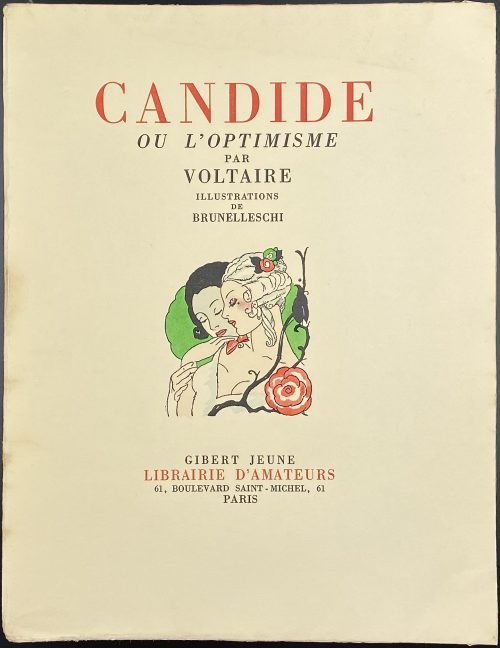 Title (in red and black): CANDIDE | OU L'OPTIMISME | PAR | VOLTAIRE | ILLUSTRATIONS | DE | BRUNELLESCHI | {vignette} | GIBERT JEUNE | LIBRAIRIE D'AMATEURS | 61, BOULEVARD SAINT-MICHEL, 61 | PARIS || Pagination : [6] 1-163 [164][2], with 23 black tailpieces, plus 16 colour plates extraneous to collation, incl. frontispiece, printed by A. Dantan and stencil-coloured (au pochoir) by E. Charpentier after gouache and watercolour drawings by Umberto Brunelleschi; total 102 leaves. Limited edition of 2500 copies, this is № 39. Printed at Imprimerie Coulouma, Argenteuil (H. Barthélemy, director) on July 15, 1933. Binding: 26.5 x 20.5 cm, publisher’s pictorial wrappers, vignettes and lettering to front wrapper and spine, publisher’s device to back wrapper. Description of the stensil (au pochoir) technique.
Title (in red and black): CANDIDE | OU L'OPTIMISME | PAR | VOLTAIRE | ILLUSTRATIONS | DE | BRUNELLESCHI | {vignette} | GIBERT JEUNE | LIBRAIRIE D'AMATEURS | 61, BOULEVARD SAINT-MICHEL, 61 | PARIS || Pagination : [6] 1-163 [164][2], with 23 black tailpieces, plus 16 colour plates extraneous to collation, incl. frontispiece, printed by A. Dantan and stencil-coloured (au pochoir) by E. Charpentier after gouache and watercolour drawings by Umberto Brunelleschi; total 102 leaves. Limited edition of 2500 copies, this is № 39. Printed at Imprimerie Coulouma, Argenteuil (H. Barthélemy, director) on July 15, 1933. Binding: 26.5 x 20.5 cm, publisher’s pictorial wrappers, vignettes and lettering to front wrapper and spine, publisher’s device to back wrapper. Description of the stensil (au pochoir) technique. -
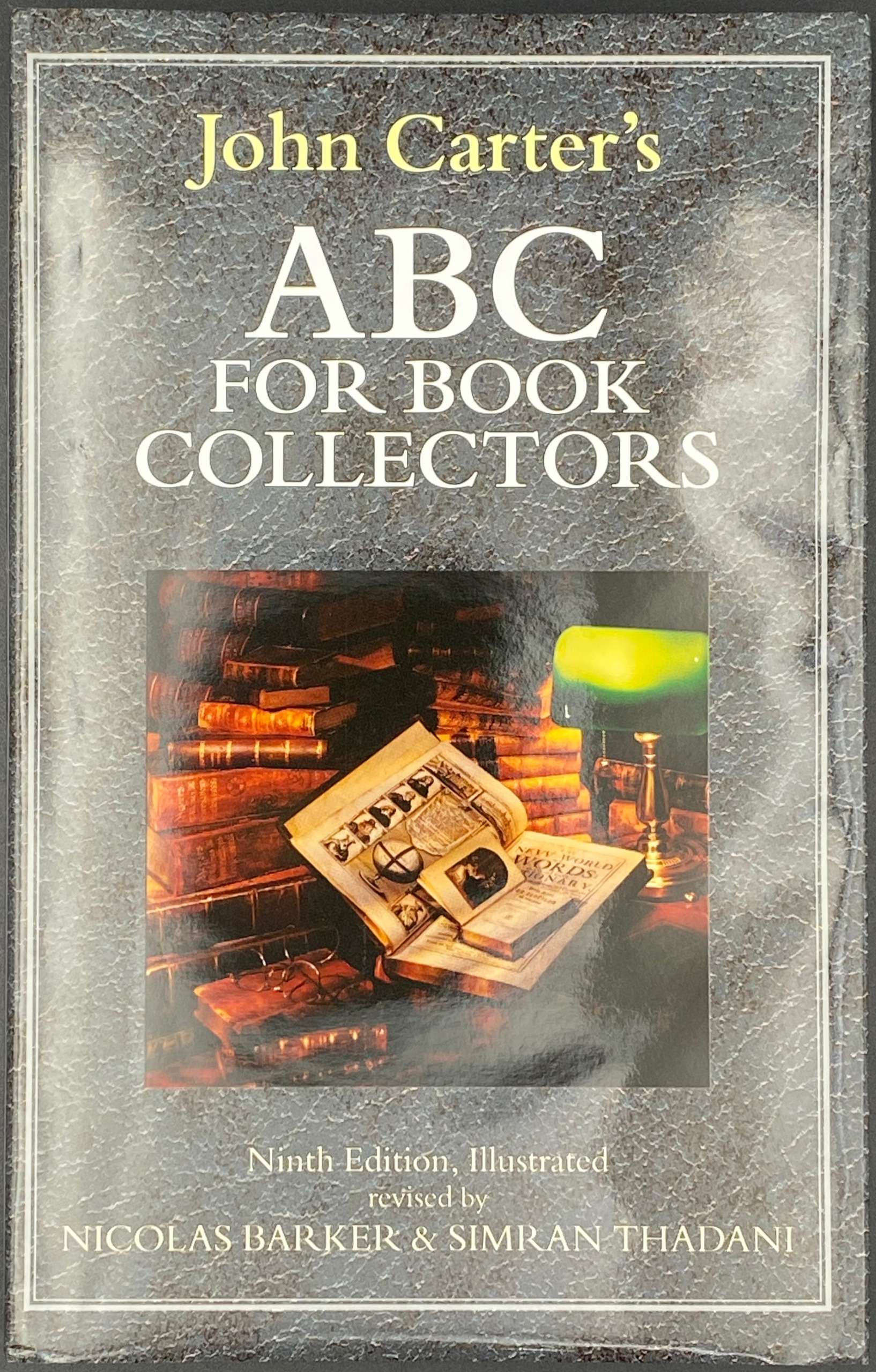 Title: John Carter's | ABC | for book collectors | Ninth Edition | Nicolas Barker & Simran Thadani | {publisher’s device} | Oak Knoll Press | New Castle, Delaware | 2016 | [TITLE-PAGE] || Pagination: [1-6] 7-263 [264]. Binding: 21 x 13.5 cm; black cloth, silver lettering to spine, pictorial dust jacket. Carter, John (British, 1905 – 1975) – author. Barker, Nicolas (British, b. 1932) – author Thadani, Simran – author
Title: John Carter's | ABC | for book collectors | Ninth Edition | Nicolas Barker & Simran Thadani | {publisher’s device} | Oak Knoll Press | New Castle, Delaware | 2016 | [TITLE-PAGE] || Pagination: [1-6] 7-263 [264]. Binding: 21 x 13.5 cm; black cloth, silver lettering to spine, pictorial dust jacket. Carter, John (British, 1905 – 1975) – author. Barker, Nicolas (British, b. 1932) – author Thadani, Simran – author -
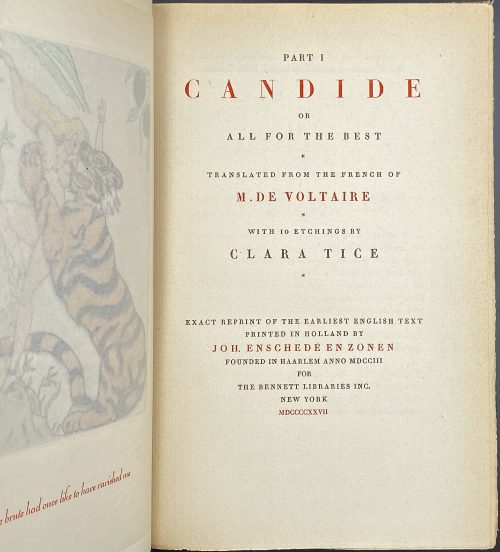 Title (in red and black): PART I | CANDIDE | OR | ALL FOR THE BEST | ★ | TRANSLATED FROM THE FRENCH OF | M. DE VOLTAIRE | ★ | WITH 10 ETCHINGS BY | CLARA TICE | ★ | EXACT REPRINT OF THE EARLIEST ENGLISH TEXT | PRINTED IN HOLLAND BY | JOH. ENSCHEDÉ EN ZONEN | FOUNDED IN HAARLEM ANNO MDCCIII | FOR | THE BENNETT LIBRARIES INC. | NEW YORK | MDCCCCXXVII || Limitation: 1,000 copies of which numbers 1 t0 250 are on a special deckle-edge Pannekoek paper; and numbers 251 to 1,000 are on papier à la cuve; this is copy № 310 (stamped in pink ink). Illustrations: 10 coloured etchings, incl. frontispiece, produced by an American artist Clara Tice (1888 – 1973) on a watermarked laid paper and bound in with tissue guards, lettered in red. Binding: 23.5 x 15.3 cm, quarter black buckram over wrinkled faux-marbled paper painted with gilt, gilt design and lettering to spine, black endpapers (both flyleaves present), top margin gilt, other trimmed rough. Collation: [10] – five blank leaves, [2] – h.t. / limitation, [2] – t.p. / imprint, 7-119 [120 blank], [121-2] – part 2 d.t.p. / blank, 123-182, [183-9] – contents, [190 blank], [10] – five blank leaves, the first blank uncut from [189/90]; total number of pages 216; total number of leaves 108 plus 10 plates with tissue guards, incl. frontispiece. Contributors: François-Marie Arouet [Voltaire] (French, 1694 – 1778)– author. Tobias George Smollett (British, 1721 – 1771) – translator (translation of 1759). Clara Tice (American, 1888 – 1973) – artist. The Bennett Libraries (NY) – publisher. Johannes Enschedé en Zonen (Haarlem) – printer.
Title (in red and black): PART I | CANDIDE | OR | ALL FOR THE BEST | ★ | TRANSLATED FROM THE FRENCH OF | M. DE VOLTAIRE | ★ | WITH 10 ETCHINGS BY | CLARA TICE | ★ | EXACT REPRINT OF THE EARLIEST ENGLISH TEXT | PRINTED IN HOLLAND BY | JOH. ENSCHEDÉ EN ZONEN | FOUNDED IN HAARLEM ANNO MDCCIII | FOR | THE BENNETT LIBRARIES INC. | NEW YORK | MDCCCCXXVII || Limitation: 1,000 copies of which numbers 1 t0 250 are on a special deckle-edge Pannekoek paper; and numbers 251 to 1,000 are on papier à la cuve; this is copy № 310 (stamped in pink ink). Illustrations: 10 coloured etchings, incl. frontispiece, produced by an American artist Clara Tice (1888 – 1973) on a watermarked laid paper and bound in with tissue guards, lettered in red. Binding: 23.5 x 15.3 cm, quarter black buckram over wrinkled faux-marbled paper painted with gilt, gilt design and lettering to spine, black endpapers (both flyleaves present), top margin gilt, other trimmed rough. Collation: [10] – five blank leaves, [2] – h.t. / limitation, [2] – t.p. / imprint, 7-119 [120 blank], [121-2] – part 2 d.t.p. / blank, 123-182, [183-9] – contents, [190 blank], [10] – five blank leaves, the first blank uncut from [189/90]; total number of pages 216; total number of leaves 108 plus 10 plates with tissue guards, incl. frontispiece. Contributors: François-Marie Arouet [Voltaire] (French, 1694 – 1778)– author. Tobias George Smollett (British, 1721 – 1771) – translator (translation of 1759). Clara Tice (American, 1888 – 1973) – artist. The Bennett Libraries (NY) – publisher. Johannes Enschedé en Zonen (Haarlem) – printer. -
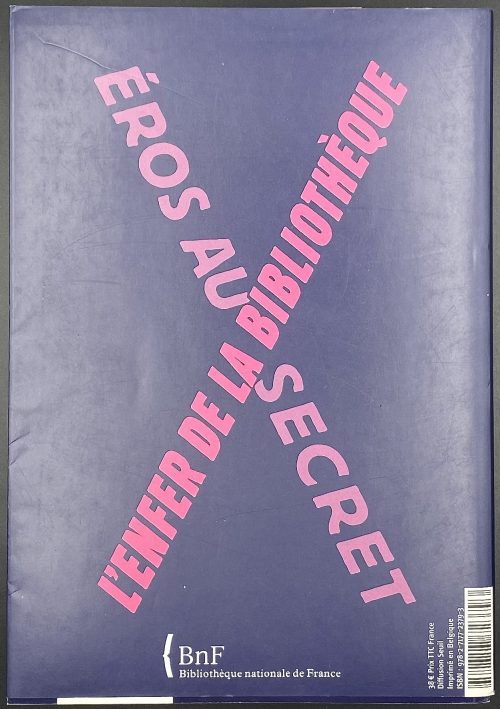 Exhibition held December 4, 2007, to March 2, 2008, at the Bibliothèque Nationale de France. Title: L'enfer de la Bibliothèque | ÉROS AU SECRET | Sous la direction | de Marie-Françoise Quignard | et Raymond-Josué Seckel | [spase] | {BnF | Bibliothèque nationale de France || Description: 23 x 16 cm, publisher’s lettered wrappers and pictorial dust jacket, [1-17] 18-460 [4], ils.; 257 entries, 8 pp. bibliography, 10 pp. index.
Exhibition held December 4, 2007, to March 2, 2008, at the Bibliothèque Nationale de France. Title: L'enfer de la Bibliothèque | ÉROS AU SECRET | Sous la direction | de Marie-Françoise Quignard | et Raymond-Josué Seckel | [spase] | {BnF | Bibliothèque nationale de France || Description: 23 x 16 cm, publisher’s lettered wrappers and pictorial dust jacket, [1-17] 18-460 [4], ils.; 257 entries, 8 pp. bibliography, 10 pp. index. -
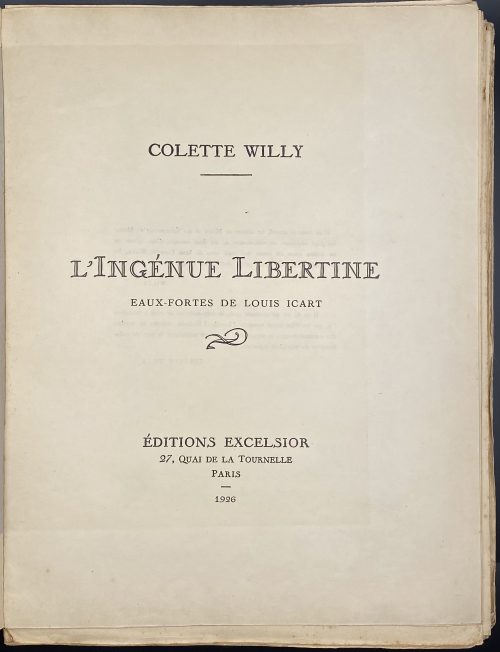 Title-page: COLETTE WILLY | — | L'ingénue libertine | EAUX-FORTES DE LOUIS ICART | ❧ | ÉDITIONS EXCELSIOR | 27, Quai de la Tournelle | Paris | 1926 || Description: French cream flapped wrappers 33.5 x 26 cm with gilt lettering to front and spine, printed on wove paper (Japon Impérial), [2] blank, [1-4] h.t. / limitation, t.p. / citations, 5-191 [3] colophon, plus 20 plates of coloured etchings and 20 plates of b/w etchings, incl. frontispiece. Edition enriched with an autograph letter signed by Colette tipped in after limitation. Edition: limited to 546 copies of which one (№ UN) is unique, printed on Papier de Chine with original colour drawings, 55 (№ 1-50 + 5 H.C.) on Japon Impérial, 65 (№ 51-100 +15 H.C.) on Hollande van Gelder, and 425 (№ 101-500 + 25 H.C.) on vergé paper BFK Rives. This copy is № 48, enriched with Colette a.l.s. and an extra suite of plates. Printed on December 3, 1926, at Arrault et Cie in Tours. Transcript of a.l.s.: "De deux romans (Minne et Les égarements de Minne) qui ne portèrent pas ma signature, j’en ai fait un seul : l’Ingénue libertine. La première partie trouve encore grâce à mes yeux ; je suis plus sévère pour la deuxième et dernière, [mot rayé] superflue et qui sent le travail. Cette libertine aurait bien dû en rester à l’ingénuité. — Colette" Contributors: Sidonie-Gabrielle Colette [a.k.a. Colette] (French, 1873 – 1954) – author. Henry Gauthier-Villars [a.k.a. Willy] (French, 1859 – 1931) – author. Louis Icart (French, 1888 – 1950) – artist.
Title-page: COLETTE WILLY | — | L'ingénue libertine | EAUX-FORTES DE LOUIS ICART | ❧ | ÉDITIONS EXCELSIOR | 27, Quai de la Tournelle | Paris | 1926 || Description: French cream flapped wrappers 33.5 x 26 cm with gilt lettering to front and spine, printed on wove paper (Japon Impérial), [2] blank, [1-4] h.t. / limitation, t.p. / citations, 5-191 [3] colophon, plus 20 plates of coloured etchings and 20 plates of b/w etchings, incl. frontispiece. Edition enriched with an autograph letter signed by Colette tipped in after limitation. Edition: limited to 546 copies of which one (№ UN) is unique, printed on Papier de Chine with original colour drawings, 55 (№ 1-50 + 5 H.C.) on Japon Impérial, 65 (№ 51-100 +15 H.C.) on Hollande van Gelder, and 425 (№ 101-500 + 25 H.C.) on vergé paper BFK Rives. This copy is № 48, enriched with Colette a.l.s. and an extra suite of plates. Printed on December 3, 1926, at Arrault et Cie in Tours. Transcript of a.l.s.: "De deux romans (Minne et Les égarements de Minne) qui ne portèrent pas ma signature, j’en ai fait un seul : l’Ingénue libertine. La première partie trouve encore grâce à mes yeux ; je suis plus sévère pour la deuxième et dernière, [mot rayé] superflue et qui sent le travail. Cette libertine aurait bien dû en rester à l’ingénuité. — Colette" Contributors: Sidonie-Gabrielle Colette [a.k.a. Colette] (French, 1873 – 1954) – author. Henry Gauthier-Villars [a.k.a. Willy] (French, 1859 – 1931) – author. Louis Icart (French, 1888 – 1950) – artist. -
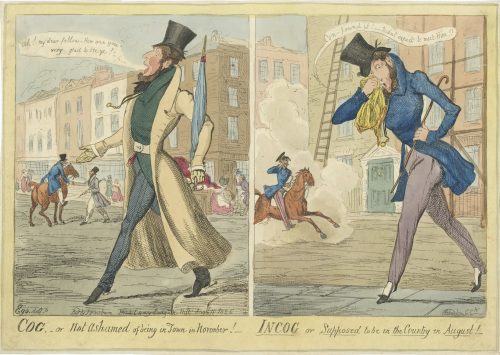 Description by British Museum (1865,1111.2128): "Two designs, side by side. [1] A dandy (probably a portrait), florid, whiskered, and bearded, steps jauntily from the pavement, hand extended, saying: Ah! my dear fellow — How are you? Devilish glad to see ye!— He holds a closed umbrella, ferrule erect, and wears a long tight-waisted coat to the heels, unbuttoned, tight pantaloons and spurred boots. In the middle distance, another dandy grasps the hand of a friend on horseback. Behind are houses with shop-fronts. A man raises his hat to a lady who curtseys. [2] The same dandy steps from the roadway onto the pavement, his handkerchief to his nose; he stoops, trying to conceal himself from a dandy cantering past in a cloud of dust, his eye-glass to his eye. He is without gloves, extraordinary for a dandy, and his trousers are strapped over pumps; he says: Con-found it! — Didn't expect to meet Him!! The street is otherwise empty; against the (large) houses are scaffolding and a tall ladder." Lettered with title, text within image including production details: 'Ego. delt / Etched by G. Ck / Pubd by J Fairburn Broadway Ludgate Hill August 18 1826'. Dimensions: Sheet: 25.5 x 36 cm, Image: 21.7 x 33.8 cm. Catalogue raisonné: A. M. Cohn (1924): № 1001, p. 262.: "A wretched plate. Difficult to believe G. C. had anything to do with it." — Bruton. Value.— £1.
Description by British Museum (1865,1111.2128): "Two designs, side by side. [1] A dandy (probably a portrait), florid, whiskered, and bearded, steps jauntily from the pavement, hand extended, saying: Ah! my dear fellow — How are you? Devilish glad to see ye!— He holds a closed umbrella, ferrule erect, and wears a long tight-waisted coat to the heels, unbuttoned, tight pantaloons and spurred boots. In the middle distance, another dandy grasps the hand of a friend on horseback. Behind are houses with shop-fronts. A man raises his hat to a lady who curtseys. [2] The same dandy steps from the roadway onto the pavement, his handkerchief to his nose; he stoops, trying to conceal himself from a dandy cantering past in a cloud of dust, his eye-glass to his eye. He is without gloves, extraordinary for a dandy, and his trousers are strapped over pumps; he says: Con-found it! — Didn't expect to meet Him!! The street is otherwise empty; against the (large) houses are scaffolding and a tall ladder." Lettered with title, text within image including production details: 'Ego. delt / Etched by G. Ck / Pubd by J Fairburn Broadway Ludgate Hill August 18 1826'. Dimensions: Sheet: 25.5 x 36 cm, Image: 21.7 x 33.8 cm. Catalogue raisonné: A. M. Cohn (1924): № 1001, p. 262.: "A wretched plate. Difficult to believe G. C. had anything to do with it." — Bruton. Value.— £1. -
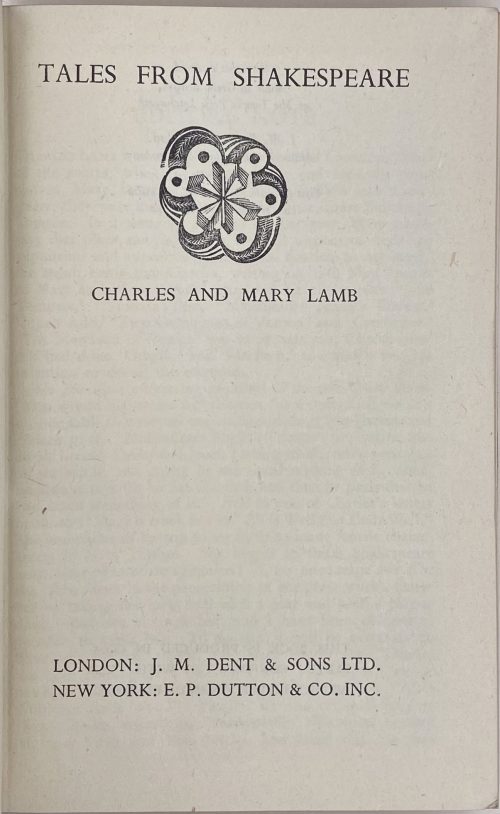 Description: 17.4 x 11 cm, blue publisher’s cloth, blind device to front board, gilt lettering to spine, no DJ, pink abstract diaper endpapers, owner’s ink inscription to ffep, dated June 28, 1945. Serial t.p.: Everyman, I will go with thee, and be thy guide, | In thy most need to go by the side. | — | EVERYMAN'S LIBRARY | EDITED BY ERNEST RHYS | No. 8 | FOR YOUNG PEOPLE | TALES FROM SHAKESPEARE | BY CHARLES AND MARY LAMB | ILLUSTRATIONS BY ARTHUR | RACKHAM || Title-page: TALES FROM SHAKESPEARE | {device} | CHARLES AND MARY LAMB | LONDON: J. M. DENT & SONS LTD. | NEW YORK: E. P. DUTTON & CO. INC. || T.p verso: All rights reserved | Made in Great Britain | at The Temple Press Letchworth | for | J. M. Dent & Sons Ltd. | Aldine House Bedford St. London | First published 1807 | First published in this edition 1906 | Last reprint (reset) 1944 | [blank] | THIS BOOK IS PRODUCED IN COM- | PLETE CONFORMITY WITH THE | AUTHORIZED ECONOMY STANDARDS || Collation: 16mo; [A]-K16; total 160 leaves, 9 full-page illustrations after Arthur Rackham, within collation (text on the other side). Pagination: [i-iv] v-viii, 1-312, total 320 pages, ils. Contributors: William Shakespeare (English, 1564 – 1616) Mary Ann Lamb (British, 1764 – 1847) – author. Charles Lamb (British, 1775 – 1834) – author. Ernest Percival Rhys (British, 1859 – 1946) – editor. Arthur Rackham (British, 1867 – 1939) – artist.
Description: 17.4 x 11 cm, blue publisher’s cloth, blind device to front board, gilt lettering to spine, no DJ, pink abstract diaper endpapers, owner’s ink inscription to ffep, dated June 28, 1945. Serial t.p.: Everyman, I will go with thee, and be thy guide, | In thy most need to go by the side. | — | EVERYMAN'S LIBRARY | EDITED BY ERNEST RHYS | No. 8 | FOR YOUNG PEOPLE | TALES FROM SHAKESPEARE | BY CHARLES AND MARY LAMB | ILLUSTRATIONS BY ARTHUR | RACKHAM || Title-page: TALES FROM SHAKESPEARE | {device} | CHARLES AND MARY LAMB | LONDON: J. M. DENT & SONS LTD. | NEW YORK: E. P. DUTTON & CO. INC. || T.p verso: All rights reserved | Made in Great Britain | at The Temple Press Letchworth | for | J. M. Dent & Sons Ltd. | Aldine House Bedford St. London | First published 1807 | First published in this edition 1906 | Last reprint (reset) 1944 | [blank] | THIS BOOK IS PRODUCED IN COM- | PLETE CONFORMITY WITH THE | AUTHORIZED ECONOMY STANDARDS || Collation: 16mo; [A]-K16; total 160 leaves, 9 full-page illustrations after Arthur Rackham, within collation (text on the other side). Pagination: [i-iv] v-viii, 1-312, total 320 pages, ils. Contributors: William Shakespeare (English, 1564 – 1616) Mary Ann Lamb (British, 1764 – 1847) – author. Charles Lamb (British, 1775 – 1834) – author. Ernest Percival Rhys (British, 1859 – 1946) – editor. Arthur Rackham (British, 1867 – 1939) – artist.Temple Press, Letchworth, England – printer.
Joseph Malaby Dent (British, 1849 – 1926) – publisher. Note: “On the writing desk were two books – identical copies of Lamb’s Tales From Shakespeare. […] — Why did you choose Lamb? — It was the only book I could find in duplicate except Uncle Tom’s Cabin…” Graham Greene. Our Man in Havana. -
 Title: On the Banks of the Kamo River [加茂堤] (Kamo Tsutsumi), sometimes transcribed as Kamo Zutsumi. Series: A Parody of Sugawara [美立菅原] (Mitate Sugawara). The word mitate is usually written as 見立 but here it is 美立, like on another Kunisada's fan print A beauty reading a book on a balcony overlooking a bay: A Parody of Sugawara Stripes (see SVJP-0334.2021 in this collection). On the Banks of the Kamo River is a scene from the play Sugawara's Secrets of Calligraphy [菅原伝授手習鑑] (Sugawara Denju Tenarai Kagami); it was originally written for the puppet theatre (Bunraku) and staged for the first time in the 8th lunar month of 1746 in Ôsaka at the Takemotoza. It was adapted for Kabuki the following month and staged for the first time in Kyôto at the Kitagawa no Shibai, produced by Nakamura Kiyosaburô I. It was also performed for the first time in Edo, at the Ichimuraza, in the 3rd lunar month of 1747. The shape of the cartouche resembles an ox cart viewed from the back which alludes to the scene Fighting for the Carriage (Kuruma biki). Artist: Utagawa Kunisada [歌川 国貞] a.k.a. Utagawa Toyokuni III [三代 歌川 豊国] (Japanese, 1786 – 1865). Signed: Toyokuni [豊国] in a red toshidama cartouche. The character ga [画] is missing (cut out). Publisher’s seal: Ibaya Senzaburō [伊場屋仙三郎] (Japanese, fl. 1815 – 1869). The date seal and censor seals were possibly trimmed out. According to [LIB-3008.2022] Andreas Marks (Tuttle, 2010; p. 267), the series was produced by Ibaya in 1851. Ref.: (1) Samuel L. Leiter. Historical dictionary of Japanese traditional theatre (Historical dictionaries of literature and the arts) / 2nd edition. – Lanham: Rowman & Littlefield, 2014©. (2) Andreas Marks. Japanese woodblock prints: Artists, publishers and masterworks, 1680 – 1900 / Foreword by Stephen Addiss. — Tuttle Publishing, 2010©. Acknowledgements: This masterpiece of ukiyo-e would not be properly described without input from Elena Varshavsky and Horst Graebner.
Title: On the Banks of the Kamo River [加茂堤] (Kamo Tsutsumi), sometimes transcribed as Kamo Zutsumi. Series: A Parody of Sugawara [美立菅原] (Mitate Sugawara). The word mitate is usually written as 見立 but here it is 美立, like on another Kunisada's fan print A beauty reading a book on a balcony overlooking a bay: A Parody of Sugawara Stripes (see SVJP-0334.2021 in this collection). On the Banks of the Kamo River is a scene from the play Sugawara's Secrets of Calligraphy [菅原伝授手習鑑] (Sugawara Denju Tenarai Kagami); it was originally written for the puppet theatre (Bunraku) and staged for the first time in the 8th lunar month of 1746 in Ôsaka at the Takemotoza. It was adapted for Kabuki the following month and staged for the first time in Kyôto at the Kitagawa no Shibai, produced by Nakamura Kiyosaburô I. It was also performed for the first time in Edo, at the Ichimuraza, in the 3rd lunar month of 1747. The shape of the cartouche resembles an ox cart viewed from the back which alludes to the scene Fighting for the Carriage (Kuruma biki). Artist: Utagawa Kunisada [歌川 国貞] a.k.a. Utagawa Toyokuni III [三代 歌川 豊国] (Japanese, 1786 – 1865). Signed: Toyokuni [豊国] in a red toshidama cartouche. The character ga [画] is missing (cut out). Publisher’s seal: Ibaya Senzaburō [伊場屋仙三郎] (Japanese, fl. 1815 – 1869). The date seal and censor seals were possibly trimmed out. According to [LIB-3008.2022] Andreas Marks (Tuttle, 2010; p. 267), the series was produced by Ibaya in 1851. Ref.: (1) Samuel L. Leiter. Historical dictionary of Japanese traditional theatre (Historical dictionaries of literature and the arts) / 2nd edition. – Lanham: Rowman & Littlefield, 2014©. (2) Andreas Marks. Japanese woodblock prints: Artists, publishers and masterworks, 1680 – 1900 / Foreword by Stephen Addiss. — Tuttle Publishing, 2010©. Acknowledgements: This masterpiece of ukiyo-e would not be properly described without input from Elena Varshavsky and Horst Graebner. -
![Война мышей и лягушек. Батрахомиомахия / Пер. с древнегреческого, вводн. стат. и коммент. М.С.Альтмана. Иллюстр. А. И. Порет, переплет и обложка по ее же рисункам. С суперобложкой. — М.-Л.: Academia, 1936. — XV, [I], 21, [2] стр. (Античная литература под общей ред. Д. А. Горбова и В. О. Нилендера.](https://varshavskycollection.com/wp-content/uploads/2021/02/LIB-0985.2016-a-500x706.jpeg) Description: white paper hardcover, lettered to front, 25.8 x 18 cm, in pictorial dust jacket; pagination: [i-vi] vii-xv [xvi] [2] 3-21 [3], errata slip bound in; one folding plate bound in after p.8. Title-page: ВОЙНА | МЫШЕЙ И ЛЯГУШЕК | (БАТРАХОМИОМАХИЯ) | Перевод с древнегреческого, | вводная статья | и комментарии | М. С. АЛЬТМАНА | ACADEMIA | 1936 || Opposite title: АНТИЧНАЯ ЛИТЕРАТУРА | под общей редакцией | Д. А. ГОРБОВА И В. О. НИЛЕНДЕРА | БАТРАХОМИОМАХИЯ | ACADEMIA | Москва – Ленинград || Title verso: ΒΑΤΡΑΧΟΜΥΟΜΑΧΊΑ | Иллюстрация А. И. Порет | Переплет и суперобложка | по ее же рисункам || Print run: 10,300 copies. Catalogue raisonné: Крылов-Кичатова № 798, p. 274. Contributors: Альтман, Моисей Семёнович (Russian-Jewish, 1896—1986) – translator, author Порет, Алиса Ивановна (Russian, 1902 – 1984) – artist.
Description: white paper hardcover, lettered to front, 25.8 x 18 cm, in pictorial dust jacket; pagination: [i-vi] vii-xv [xvi] [2] 3-21 [3], errata slip bound in; one folding plate bound in after p.8. Title-page: ВОЙНА | МЫШЕЙ И ЛЯГУШЕК | (БАТРАХОМИОМАХИЯ) | Перевод с древнегреческого, | вводная статья | и комментарии | М. С. АЛЬТМАНА | ACADEMIA | 1936 || Opposite title: АНТИЧНАЯ ЛИТЕРАТУРА | под общей редакцией | Д. А. ГОРБОВА И В. О. НИЛЕНДЕРА | БАТРАХОМИОМАХИЯ | ACADEMIA | Москва – Ленинград || Title verso: ΒΑΤΡΑΧΟΜΥΟΜΑΧΊΑ | Иллюстрация А. И. Порет | Переплет и суперобложка | по ее же рисункам || Print run: 10,300 copies. Catalogue raisonné: Крылов-Кичатова № 798, p. 274. Contributors: Альтман, Моисей Семёнович (Russian-Jewish, 1896—1986) – translator, author Порет, Алиса Ивановна (Russian, 1902 – 1984) – artist. -
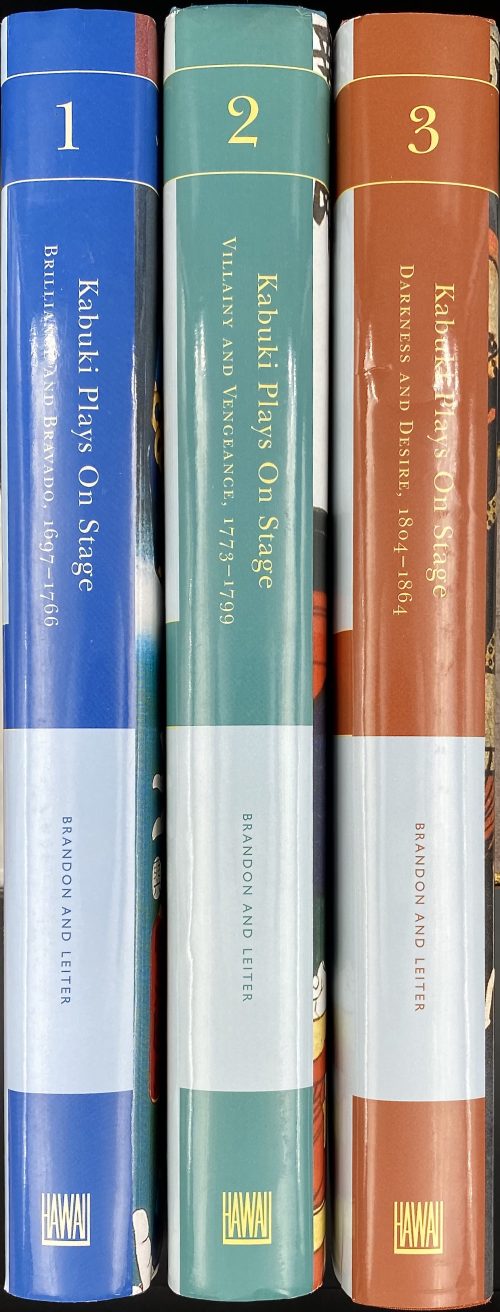 Three volumes, 26.2 x 18.6 cm each: Vol. 1: Kabuki plays on stage: Brilliance and Bravado, 1697-1766; pp.: [i-viii] ix-xiii [xiv blank], 1-391 [1 blank], total 203 leaves, ils. Blue buckram gilt-lettered on spine, pictorial DJ. Vol. 2: Kabuki plays on stage: Villainy and Vengeance, 1773-1799; pp.: [i-viii] ix-xiii [xiv blank], 1-413 [3 blank], total 215 leaves, ils. Green buckram gilt-lettered on spine, pictorial DJ. Vol. 3: Kabuki plays on stage: Darkness and Desire, 1804-1864; pp.: [i-viii] ix-xv [xvi blank], [1] 2-397 [3 blank], total 208 leaves, ils. Ochre buckram gilt-lettered on spine, pictorial DJ. (Vol. 4: Restoration and reform, 1872-1905 – absent for the reason of no interest in the covered period). Contributors: James Rodger Brandon (American, 1927 – 2015) Samuel L. Leiter (American, b. 1940)
Three volumes, 26.2 x 18.6 cm each: Vol. 1: Kabuki plays on stage: Brilliance and Bravado, 1697-1766; pp.: [i-viii] ix-xiii [xiv blank], 1-391 [1 blank], total 203 leaves, ils. Blue buckram gilt-lettered on spine, pictorial DJ. Vol. 2: Kabuki plays on stage: Villainy and Vengeance, 1773-1799; pp.: [i-viii] ix-xiii [xiv blank], 1-413 [3 blank], total 215 leaves, ils. Green buckram gilt-lettered on spine, pictorial DJ. Vol. 3: Kabuki plays on stage: Darkness and Desire, 1804-1864; pp.: [i-viii] ix-xv [xvi blank], [1] 2-397 [3 blank], total 208 leaves, ils. Ochre buckram gilt-lettered on spine, pictorial DJ. (Vol. 4: Restoration and reform, 1872-1905 – absent for the reason of no interest in the covered period). Contributors: James Rodger Brandon (American, 1927 – 2015) Samuel L. Leiter (American, b. 1940) -
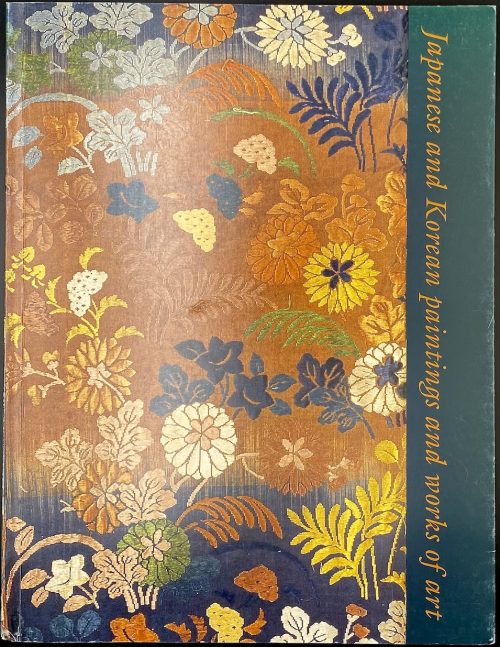 Softcover, in flapped pictorial wrappers, 28 x 21.6 cm, 35 entries, with colour illustrations. Catalogue # 6 of the sales exhibition on March 19-24, 2002 in NY; pagination: [1-3] 4-82 [2], ils., some folding. Contributor: Sebastian Izzard
Softcover, in flapped pictorial wrappers, 28 x 21.6 cm, 35 entries, with colour illustrations. Catalogue # 6 of the sales exhibition on March 19-24, 2002 in NY; pagination: [1-3] 4-82 [2], ils., some folding. Contributor: Sebastian Izzard -
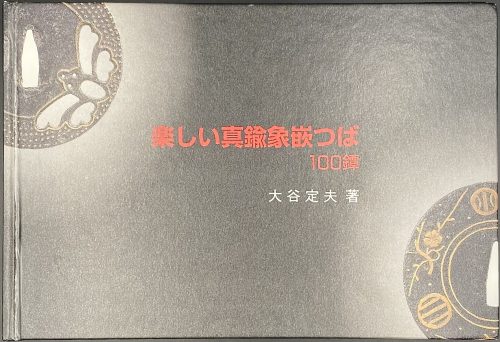 Description: Hardcover oblong volume 16 x 23.3 cm with black pictorial paper boards lettered in red and white to front cover and spine, in an ochre slipcase sprinkled brown and lettered in black to front and spine; grey endpapers, pp. [2] 3-130 [2], with a bookshop ticket to back pastedown “ISSHINDō”. Illustrated descriptions of 100 Japanese sword handguards (tsuba) with brass inlay. Title-page: 楽しい真鍮象嵌つば | 100 鐔 | 大谷定夫著 [Tanoshii Shinchū-Zōgan Tsuba | Hyakutan | Ōya Sadao cho] (Enjoying Brass Inlay Sword Guards | 100 Sword Guards | Author: Ōya Sadao) Colophon: Published December 15, 1999 Price: ¥3,800 (base price ¥3,619) Author: Ōya Sadao (大谷定夫) Producer: Ōtsuka Kōgeisha International Publisher: Ōtsuka Kōgeisha Co. Ltd. (大塚工藝社)Phone 103–0016 Tōkyō-to, Chūō-ku, Nihonbashi Koami-chō 1–5 Tel. 03–5642–3511 (Representative) Fax 03–5642–3618 Design: Takahashi Tōru (高橋享) Photography: Kitami Noboru (北見登) Kishioka Yasuhiro (岸岡保弘) ISBN4–900298–03–4 C0072 ¥3619E Subject: Ōnin tsuba; Heianjō tsuba; Suemon-zōgan; Ten-zōgan; Japanese sword handguards; Japanese sword fittings; Tosogu.
Description: Hardcover oblong volume 16 x 23.3 cm with black pictorial paper boards lettered in red and white to front cover and spine, in an ochre slipcase sprinkled brown and lettered in black to front and spine; grey endpapers, pp. [2] 3-130 [2], with a bookshop ticket to back pastedown “ISSHINDō”. Illustrated descriptions of 100 Japanese sword handguards (tsuba) with brass inlay. Title-page: 楽しい真鍮象嵌つば | 100 鐔 | 大谷定夫著 [Tanoshii Shinchū-Zōgan Tsuba | Hyakutan | Ōya Sadao cho] (Enjoying Brass Inlay Sword Guards | 100 Sword Guards | Author: Ōya Sadao) Colophon: Published December 15, 1999 Price: ¥3,800 (base price ¥3,619) Author: Ōya Sadao (大谷定夫) Producer: Ōtsuka Kōgeisha International Publisher: Ōtsuka Kōgeisha Co. Ltd. (大塚工藝社)Phone 103–0016 Tōkyō-to, Chūō-ku, Nihonbashi Koami-chō 1–5 Tel. 03–5642–3511 (Representative) Fax 03–5642–3618 Design: Takahashi Tōru (高橋享) Photography: Kitami Noboru (北見登) Kishioka Yasuhiro (岸岡保弘) ISBN4–900298–03–4 C0072 ¥3619E Subject: Ōnin tsuba; Heianjō tsuba; Suemon-zōgan; Ten-zōgan; Japanese sword handguards; Japanese sword fittings; Tosogu. -
 Artist: Utagawa Sadahide [歌川 貞秀], a.k.a. Gountei Sadahide [五雲亭 貞秀] (1807 – c. 1878/9). Signed: Gountei Sadahide ga [五雲亭貞秀画] Pubisher: Ibaya Senzaburō [伊場屋仙三郎] (Japanese, 1815 – 1869) Date-aratame seal: Bunsei 13 / Tenpō 1 (1830). Ref: Ritsumeikan University # Z0172-587. Title: Yukari no Edo-zakura [ゆかりの江戸桜], often translated into English as 'The Flower of Edo', is a one-act kabuki play Sukeroku, written by Tsuuchi Han'emon (fl. 1701 – 1743) under the supervision of Tsuuchi Jihei II (1673 – 1760 ) at the beginning of the 18th century. From the beginning of the 19th century, the play was performed in the style of katōbushi. 助六所縁江戸桜(すけろくゆかりのえどざくら。「助六」– one of the main melodies in katōbushi (河東節) type of jōruri [浄瑠璃]. For a detailed explanation in Japanese, see also HERE). Plot: In search of the stolen Minamoto clan's precious sword called Tomokirimaru, Soga Gorō (historical Soga Tokimune [曾我時致], 1174 – 1193) came to a Yoshiwara brothel under the disguise of a debaucher named Hanagawado Sukeroku. His elder brother, Soga Jūrō (historical Soga Sukenari [曾我祐成], 1172 – 1193) ), has assumed the guise of a wine vendor Shinbei. The character who had the Tomokirimaru sword was Ikyū (historical Iga no Heinaizaemon, a Tiara clan's ally), see SVJP-0164.2014. A series of three prints is dedicated to a katōbushi performance of the Soga-themed plays.
Artist: Utagawa Sadahide [歌川 貞秀], a.k.a. Gountei Sadahide [五雲亭 貞秀] (1807 – c. 1878/9). Signed: Gountei Sadahide ga [五雲亭貞秀画] Pubisher: Ibaya Senzaburō [伊場屋仙三郎] (Japanese, 1815 – 1869) Date-aratame seal: Bunsei 13 / Tenpō 1 (1830). Ref: Ritsumeikan University # Z0172-587. Title: Yukari no Edo-zakura [ゆかりの江戸桜], often translated into English as 'The Flower of Edo', is a one-act kabuki play Sukeroku, written by Tsuuchi Han'emon (fl. 1701 – 1743) under the supervision of Tsuuchi Jihei II (1673 – 1760 ) at the beginning of the 18th century. From the beginning of the 19th century, the play was performed in the style of katōbushi. 助六所縁江戸桜(すけろくゆかりのえどざくら。「助六」– one of the main melodies in katōbushi (河東節) type of jōruri [浄瑠璃]. For a detailed explanation in Japanese, see also HERE). Plot: In search of the stolen Minamoto clan's precious sword called Tomokirimaru, Soga Gorō (historical Soga Tokimune [曾我時致], 1174 – 1193) came to a Yoshiwara brothel under the disguise of a debaucher named Hanagawado Sukeroku. His elder brother, Soga Jūrō (historical Soga Sukenari [曾我祐成], 1172 – 1193) ), has assumed the guise of a wine vendor Shinbei. The character who had the Tomokirimaru sword was Ikyū (historical Iga no Heinaizaemon, a Tiara clan's ally), see SVJP-0164.2014. A series of three prints is dedicated to a katōbushi performance of the Soga-themed plays.
They all have a background of hail patterns (Arare-ko-mon) [霰小紋], similar to Kunisada’s Iwai Kumesaburō II as An no Heibei [SVJP-0304.2019], see below.Yukari no Edo-zakura The tatami night robe of Iwao Tangled Hair and the Evening Braided Hat 
-
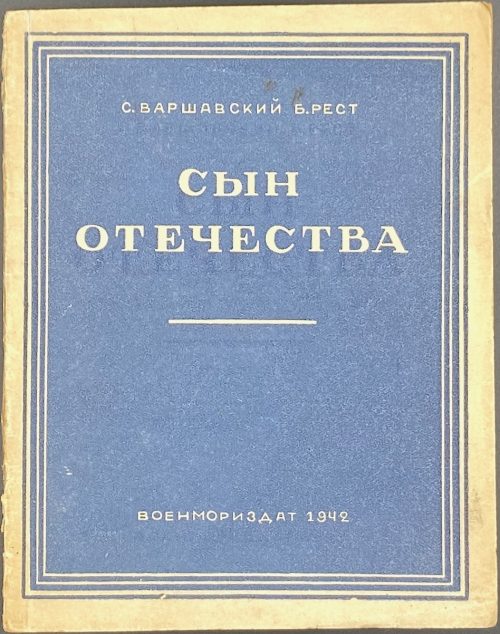 Description: softcover, 16.5 x 13 cm, in wrappers, white lettering on blue panel to front: “C. ВАРШАВСКИЙ Б. РЕСТ | СЫН | ОТЕЧЕСТВА | — | ВОЕНМОРИЗДАТ 1942”. Pagination: [2] 3-71 [72]; collated 8vo: [1]-48 54, total 36 leaves. Title-page: СМЕРТЬ НЕМЕЦКИМ ОККУПАНТАМ! | БИБЛИОТЕКА КРАСНОФЛОТЦА | C. ВАРШАВСКИЙ, Б. РЕСТ | СЫН | ОТЕЧЕСТВА | {publisher’s device} |—| ВОЕННО-МОРСКОЕ ИЗДАТЕЛЬСТВО НКВМФ СОЮЗА ССР | МОСКВА • 1942 || Another copy: LIB-3083.2022. Contributors: Сергей Петрович Варшавский [Sergei Varshavsky] (Russian-Jewish, 1906 – 1980) – author. Б. Рест (Юлий Исаакович Шапиро (Russian-Jewish, 1907 – 1984) – author.
Description: softcover, 16.5 x 13 cm, in wrappers, white lettering on blue panel to front: “C. ВАРШАВСКИЙ Б. РЕСТ | СЫН | ОТЕЧЕСТВА | — | ВОЕНМОРИЗДАТ 1942”. Pagination: [2] 3-71 [72]; collated 8vo: [1]-48 54, total 36 leaves. Title-page: СМЕРТЬ НЕМЕЦКИМ ОККУПАНТАМ! | БИБЛИОТЕКА КРАСНОФЛОТЦА | C. ВАРШАВСКИЙ, Б. РЕСТ | СЫН | ОТЕЧЕСТВА | {publisher’s device} |—| ВОЕННО-МОРСКОЕ ИЗДАТЕЛЬСТВО НКВМФ СОЮЗА ССР | МОСКВА • 1942 || Another copy: LIB-3083.2022. Contributors: Сергей Петрович Варшавский [Sergei Varshavsky] (Russian-Jewish, 1906 – 1980) – author. Б. Рест (Юлий Исаакович Шапиро (Russian-Jewish, 1907 – 1984) – author. -
 Description: Hardcover, 18.8 x 13 cm, pictorial front cover (after Franz von Bayros) in colour over tan cloth, lettering to spine, all margins red, laid paper endpapers, pp.: [4] 1-185 [3]; collated 8vo as π2 1-118, 126, total 192 pages (96 leaves) plus 5 b/w photogravures after drawings by Franz von Bayros. Title-page (blackletter): Gustav Hochstetter | Das Füsschen der gnädigen Frau | und Anderes | {publisher’s device} | {blank} | 1912 | München und Leipzig bei Georg Müller || T.p. verso (blackletter): Umschlagzeichnung und fünf Bildbeigeben von | Franz von Bayros | {blank} | (serif) Copyright 1912 by Georg Müller in München || Colophon: Druck von Mänicke u. Jahn, Rudolstadt. Contributors: Gustav Hochstetter (German-Jewish, 1873 – 1944) – author. Franz von Bayros (Austrian, 1866 – 1924) – artist. Mänicke und Jahn (Rudolstadt) – printer. Georg Müller (München, Leipzig) – publisher.
Description: Hardcover, 18.8 x 13 cm, pictorial front cover (after Franz von Bayros) in colour over tan cloth, lettering to spine, all margins red, laid paper endpapers, pp.: [4] 1-185 [3]; collated 8vo as π2 1-118, 126, total 192 pages (96 leaves) plus 5 b/w photogravures after drawings by Franz von Bayros. Title-page (blackletter): Gustav Hochstetter | Das Füsschen der gnädigen Frau | und Anderes | {publisher’s device} | {blank} | 1912 | München und Leipzig bei Georg Müller || T.p. verso (blackletter): Umschlagzeichnung und fünf Bildbeigeben von | Franz von Bayros | {blank} | (serif) Copyright 1912 by Georg Müller in München || Colophon: Druck von Mänicke u. Jahn, Rudolstadt. Contributors: Gustav Hochstetter (German-Jewish, 1873 – 1944) – author. Franz von Bayros (Austrian, 1866 – 1924) – artist. Mänicke und Jahn (Rudolstadt) – printer. Georg Müller (München, Leipzig) – publisher. -
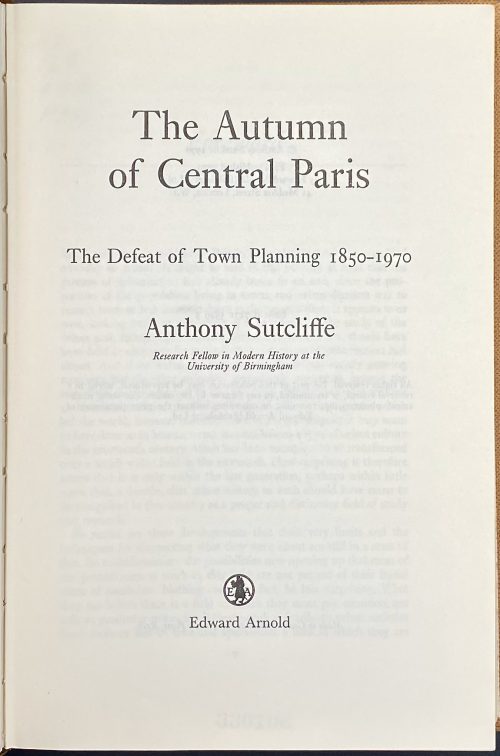 Brown cloth 24 x 15.5 cm, gilt lettering to front cover and spine, 'Cowles Library - Drake University' stamps inside and to edges, library card pocket to the pastedown, removed sticker to spine, top edge red, pictorial endpapers, pp.: [i-iv] v-xv [xvi], 1-372, total 388 pages; collated in-16mo: [1]-916 1018 11-1216, total 194 leaves plus four leaves of plates before gathering 6, four leaves of plates before gathering 9, and a folding map at the end, gathering 8 unsigned. Half-title: STUDIES IN URBAN HISTORY I | General Editor: H. J. Dyos | Reader in Urban History at the | University of Leicester || Title-page: The Autumn | of Central Paris | The Defeat of Town Planning 1850-1970 | Anthony Sutcliffe | Research Fellow in Modern History at the | University of Birmingham | {blank} | {publisher’s device} | Edward Arnold || ISBN: 9780713155495; 0713155493. OCLC Number / Unique Identifier: 1035744553. Contents: Introduction -- The Grand Design -- The Struggle to Complete the Imperial Plan -- The Period of Distractions -- Building in the Right Bank Centre, 1850 -- 1914 -- The Indian Summer of Central Paris -- The Battle for Preservation, 1850-1914 -- The Abandonment of the Grand Design -- The Approach of Obsolescence -- Victory for Preservation -- Conclusion -- Appendix I : Sources -- Appendix 2 : Graphs and Diagrams Anthony Sutcliffe (British, 1942 – 2011) – author. Harold James Dyos (British, 1921–1978) – general editor of the series.
Brown cloth 24 x 15.5 cm, gilt lettering to front cover and spine, 'Cowles Library - Drake University' stamps inside and to edges, library card pocket to the pastedown, removed sticker to spine, top edge red, pictorial endpapers, pp.: [i-iv] v-xv [xvi], 1-372, total 388 pages; collated in-16mo: [1]-916 1018 11-1216, total 194 leaves plus four leaves of plates before gathering 6, four leaves of plates before gathering 9, and a folding map at the end, gathering 8 unsigned. Half-title: STUDIES IN URBAN HISTORY I | General Editor: H. J. Dyos | Reader in Urban History at the | University of Leicester || Title-page: The Autumn | of Central Paris | The Defeat of Town Planning 1850-1970 | Anthony Sutcliffe | Research Fellow in Modern History at the | University of Birmingham | {blank} | {publisher’s device} | Edward Arnold || ISBN: 9780713155495; 0713155493. OCLC Number / Unique Identifier: 1035744553. Contents: Introduction -- The Grand Design -- The Struggle to Complete the Imperial Plan -- The Period of Distractions -- Building in the Right Bank Centre, 1850 -- 1914 -- The Indian Summer of Central Paris -- The Battle for Preservation, 1850-1914 -- The Abandonment of the Grand Design -- The Approach of Obsolescence -- Victory for Preservation -- Conclusion -- Appendix I : Sources -- Appendix 2 : Graphs and Diagrams Anthony Sutcliffe (British, 1942 – 2011) – author. Harold James Dyos (British, 1921–1978) – general editor of the series. -
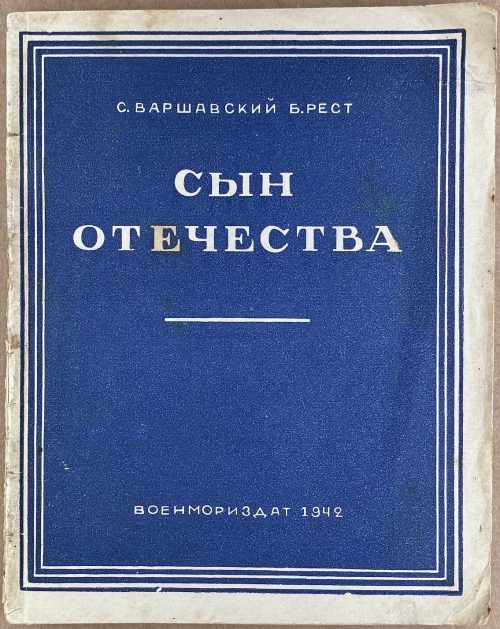 Description: softcover, 16.5 x 13 cm, in wrappers, white lettering on blue panel in white frame: “C. ВАРШАВСКИЙ Б. РЕСТ | СЫН | ОТЕЧЕСТВА | — | ВОЕНМОРИЗДАТ 1942”. Pagination: [2] 3-71 [72]; collated 8vo: [1]-48 54, total 36 leaves. Title-page: СМЕРТЬ НЕМЕЦКИМ ОККУПАНТАМ! | БИБЛИОТЕКА КРАСНОФЛОТЦА | C. ВАРШАВСКИЙ, Б. РЕСТ | СЫН | ОТЕЧЕСТВА | {publisher’s device} |—| ВОЕННО-МОРСКОЕ ИЗДАТЕЛЬСТВО НКВМФ СОЮЗА ССР | МОСКВА • 1942 || Autograph to t.p.: Дорогим друзьям | Тоне и Семе (скептику) | этот малый плод | военной эрзац-литературы | с любовью оставляет | Сергей | 3. XI. 42 || Another copy: LIB-3029.2022. Contributors: Сергей Петрович Варшавский [Sergei Varshavsky] (Russian-Jewish, 1906 – 1980) – author. Б. Рест (Юлий Исаакович Шапиро (Russian-Jewish, 1907 – 1984) – author.
Description: softcover, 16.5 x 13 cm, in wrappers, white lettering on blue panel in white frame: “C. ВАРШАВСКИЙ Б. РЕСТ | СЫН | ОТЕЧЕСТВА | — | ВОЕНМОРИЗДАТ 1942”. Pagination: [2] 3-71 [72]; collated 8vo: [1]-48 54, total 36 leaves. Title-page: СМЕРТЬ НЕМЕЦКИМ ОККУПАНТАМ! | БИБЛИОТЕКА КРАСНОФЛОТЦА | C. ВАРШАВСКИЙ, Б. РЕСТ | СЫН | ОТЕЧЕСТВА | {publisher’s device} |—| ВОЕННО-МОРСКОЕ ИЗДАТЕЛЬСТВО НКВМФ СОЮЗА ССР | МОСКВА • 1942 || Autograph to t.p.: Дорогим друзьям | Тоне и Семе (скептику) | этот малый плод | военной эрзац-литературы | с любовью оставляет | Сергей | 3. XI. 42 || Another copy: LIB-3029.2022. Contributors: Сергей Петрович Варшавский [Sergei Varshavsky] (Russian-Jewish, 1906 – 1980) – author. Б. Рест (Юлий Исаакович Шапиро (Russian-Jewish, 1907 – 1984) – author. -
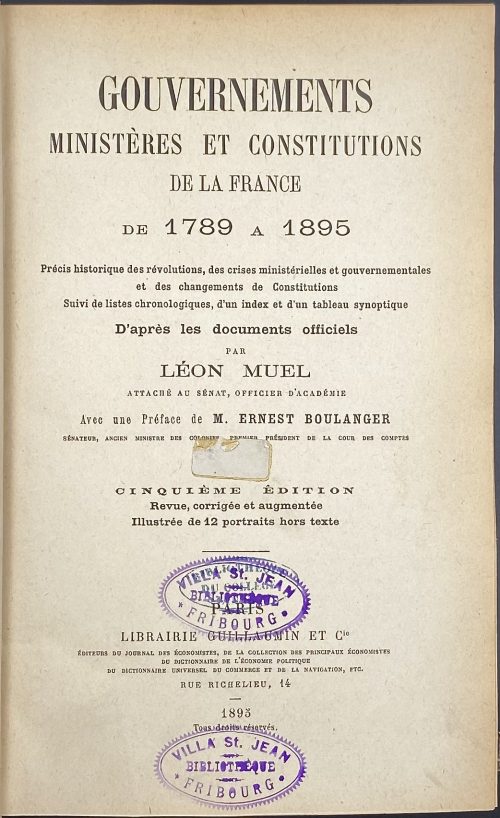 Title-page: GOUVERNEMENTS | MINISTÈRES ET CONSTITUTIONS | DE LA FRANCE | DE 1789 A 1895 | Précis historique des révolutions, des crises ministérielles et gouvernementales | et des changements de Constitutions | Suivi de listes chronologiques, d’un index et d’un tableau synoptique | D’après les documents officiels | PAR | LÉON MUEL | ATTACHÉ AU SÉNAT, OFFICIER D’ACADÉMIE | Avec une Préface de M. ERNEST BOULANGER | SÉNATEUR, ANCIEN MINISTRE DES COLONIES, PREMIER PRÉSIDENT DE LA COUR DES COMPTES | CINQUIÈME ÉDITION | Revue, corrigée et augmentée | Illustrée de 12 portraits hors texte | — | PARIS | LIBRAIRIE GUILLAUMIN ET Cie | ÉDITEURS DU JOURNAL DES ÉCONOMISTES, DE LA COLLECTION DES PRINCIPAUX ÉCONOMISTES | DU DICTIONNAIRE DE L’ÉCONOMIE POLITIQUE | DU DICTIONNAIRE UNIVERSEL DU COMMERCE ET DE LA NAVIGATION, ETC. | RUE RICHELIEU, 14 | 1895 | Tous droits réservés. || Binding: Hardcover, 22.1 x 16.6 cm x 5.0 cm, 8vo, quarter brown morocco over marbled boards, raised bands with gilt fillets and black label with gilt lettering to spine, marbled endpapers. Library stamps to t.p. and inside in blue ink: “VILLA St. JEAN | BIBLIOTHÈQUE | * FRIBOURG *”. Villa St. Jean International School, originally named Collège Villa St. Jean, was a private Catholic school in Fribourg, Switzerland, from 1903 to 1970 (see Wikipedia). Collation: ffl, π4, [1] 2-348, χ6, Suppl.: [1] 2-98, χ2, ffl; total within the flyleaves 282+76 leaves, some uncut; plus twelve plates (photographs) with tissue guards and two folding tables. Pagination: [i-v] vi-x, [2] [1] 2-4, (lacks 4: 5-8) [9] 10-535 [536] (lacks 2: 537, 538) [539] 540-557 [558 blank]; Supplément [1] 2-144, [145-6 table alphabét./blank], [147-8 table des matières/blank]; total within the flyleaves 564+148 pages, ils., plates. Provenance: Library of Villa St. Jean, Fribourg, Switzerland. Contributors: Muel, Léon (French, 1850 – 19..?) – author. Boulanger, Ernest-Théophile (French, 1831 – 1907) – author of preface. Librairie de Guillaumin et Cie – publisher. Table of contents:AVANT-PROPOSLETTRE-PRÉFACEPREMIÈRE PARTIEI. – MONARCHIE FRANÇAISE – BOURBONSLouis XVI, roi de France et de Navarre (10 MAI 1774 – 21 SEPTEMBRE 1792)II. – RÉPUBLIQUE FRANÇAISE (21 SEPTEMBRE 1792 – 18 MAI 1804)Convention nationale (20 SEPTEMBRE 1792 – 26 OCTOBRE 1795)Directoire exécutif (2 NOVEMBRE 1795 – 10 NOVEMBRE 1799)Consulat (19 BRUMAIRE AN VIII – 28 FLORÉAL AN XII) (10 NOVEMBRE 1799-18 MAI 1804);III. – EMPIRE FRANÇAIS (18 MAI 1804 – 31 MARS 1814)Napoléon Ier, Empereur des Français (18 MAI 1804 – 31 MARS 1814)Gouvernement provisoire (1er 14 AVRIL 1814)IV. – RESTAURATION – BOURBONS (14 AVRIL 1814 – 29 JUILLET 1830)Lieutenance générale du Royaume (14 AVRIL – 2 MAI 1814)Louis XVIII, roi de France et de Navarre (2 MAI 1814 – 20 MARS 1815)Cent Jours (20 MARS – 22 JUIN 1815)Commission de Gouvernement (22 JUIN – 7 JUILLET 1815)Louis XVIII, roi de France et de Navarre (8 JUILLET 1815 – 16 SEPTEMBRE 1824)Charles X, roi de France et de Navarre (16 SEPTEMBRE 1824 – 29 JUILLET 1830)Révolution de 1830Chute de Charles X et du ministère Polignac (29 JUILLET 1830). Gouvernement provisoire (29 – 31 JUILLET 1830)V. – MONARCHIE CONSTITUTIONNELLE – BRANCHE D'ORLÉANS (31 JUILLET 1830 – 24 FÉVRIER 1848)Lieutenance générale du Royaume (31 JUILLET – 9 AOUT 1830)Louis-Philippe Ier, roi des Français (9 AOUT 1830 – 24 FÉVRIER 1848)Révolution de 1848Chute du ministère Guizot (23 février) et du roi Louis-Philippe (24 février 1848)VI. – DEUXIÈME RÉPUBLIQUE FRANÇAISE (24 FÉVRIER 1848 – 2 DÉCEMBRE 1852)Gouvernement provisoire (24 FÉVRIER – 9 MAI 1848)Assemblée Nationale Constituante (4 MAI 1848 – 26 MAI 1849)Commission exécutive (9 MAI – 24 JUIN 1848)Le général Cavaignac chef du Pouvoir exécutif Président du Conseil des Ministres (28 JUIN – 20 DÉCEMBRE 1848)Louis-Napoléon Bonaparte Président de la République Française (20 DÉCEMBRE 1848 – 2 DÉCEMBRE 1852)VII. – SECOND EMPIRE FRANÇAIS (2 DÉCEMBRE 1852 – 4 SEPTEMBRE 1870)Napoléon III, empereur des Français (2 DÉCEMBRE 1852 – 4 SEPTEMBRE 1870)Révolution du 4 septembre 1870 Chute du second Empire et du ministère PalikaoVIII. – TROISIÈME RÉPUBLIQUE FRANÇAISE (4 SEPTEMBRE 1870)Gouvernement de la Défense nationale (4 SEPTEMBRE 1870 – 17 FÉVRIER 1871)Assemblée Nationale Constituante (13 FÉVRIER 1871 – 8 MARS 1876)M. Thiers Chef du Pouvoir exécutif (17 FÉVRIER – 31 AOUT 1871)M. Thiers Président de la République Française (31 AOUT 1871 – 24 MAI 1873)M. le Maréchal de Mac-Mahon, duc de Magenta Président de la République Française (24 MAI 1873 – 30 JANVIER 1879)M. Jules Grévy Président de la République Française (30 JANVIER 1879 – 2 DÉCEMBRE 1887)M. Carnot Président de la République française (3 DÉCEMBRE 1887 – 25 JUIN 1894)SECONDE PARTIE.Listes chronologiques, par ministère, de tous les ministres, depuis le 5 mai 1789 jusqu'en 1890
Title-page: GOUVERNEMENTS | MINISTÈRES ET CONSTITUTIONS | DE LA FRANCE | DE 1789 A 1895 | Précis historique des révolutions, des crises ministérielles et gouvernementales | et des changements de Constitutions | Suivi de listes chronologiques, d’un index et d’un tableau synoptique | D’après les documents officiels | PAR | LÉON MUEL | ATTACHÉ AU SÉNAT, OFFICIER D’ACADÉMIE | Avec une Préface de M. ERNEST BOULANGER | SÉNATEUR, ANCIEN MINISTRE DES COLONIES, PREMIER PRÉSIDENT DE LA COUR DES COMPTES | CINQUIÈME ÉDITION | Revue, corrigée et augmentée | Illustrée de 12 portraits hors texte | — | PARIS | LIBRAIRIE GUILLAUMIN ET Cie | ÉDITEURS DU JOURNAL DES ÉCONOMISTES, DE LA COLLECTION DES PRINCIPAUX ÉCONOMISTES | DU DICTIONNAIRE DE L’ÉCONOMIE POLITIQUE | DU DICTIONNAIRE UNIVERSEL DU COMMERCE ET DE LA NAVIGATION, ETC. | RUE RICHELIEU, 14 | 1895 | Tous droits réservés. || Binding: Hardcover, 22.1 x 16.6 cm x 5.0 cm, 8vo, quarter brown morocco over marbled boards, raised bands with gilt fillets and black label with gilt lettering to spine, marbled endpapers. Library stamps to t.p. and inside in blue ink: “VILLA St. JEAN | BIBLIOTHÈQUE | * FRIBOURG *”. Villa St. Jean International School, originally named Collège Villa St. Jean, was a private Catholic school in Fribourg, Switzerland, from 1903 to 1970 (see Wikipedia). Collation: ffl, π4, [1] 2-348, χ6, Suppl.: [1] 2-98, χ2, ffl; total within the flyleaves 282+76 leaves, some uncut; plus twelve plates (photographs) with tissue guards and two folding tables. Pagination: [i-v] vi-x, [2] [1] 2-4, (lacks 4: 5-8) [9] 10-535 [536] (lacks 2: 537, 538) [539] 540-557 [558 blank]; Supplément [1] 2-144, [145-6 table alphabét./blank], [147-8 table des matières/blank]; total within the flyleaves 564+148 pages, ils., plates. Provenance: Library of Villa St. Jean, Fribourg, Switzerland. Contributors: Muel, Léon (French, 1850 – 19..?) – author. Boulanger, Ernest-Théophile (French, 1831 – 1907) – author of preface. Librairie de Guillaumin et Cie – publisher. Table of contents:AVANT-PROPOSLETTRE-PRÉFACEPREMIÈRE PARTIEI. – MONARCHIE FRANÇAISE – BOURBONSLouis XVI, roi de France et de Navarre (10 MAI 1774 – 21 SEPTEMBRE 1792)II. – RÉPUBLIQUE FRANÇAISE (21 SEPTEMBRE 1792 – 18 MAI 1804)Convention nationale (20 SEPTEMBRE 1792 – 26 OCTOBRE 1795)Directoire exécutif (2 NOVEMBRE 1795 – 10 NOVEMBRE 1799)Consulat (19 BRUMAIRE AN VIII – 28 FLORÉAL AN XII) (10 NOVEMBRE 1799-18 MAI 1804);III. – EMPIRE FRANÇAIS (18 MAI 1804 – 31 MARS 1814)Napoléon Ier, Empereur des Français (18 MAI 1804 – 31 MARS 1814)Gouvernement provisoire (1er 14 AVRIL 1814)IV. – RESTAURATION – BOURBONS (14 AVRIL 1814 – 29 JUILLET 1830)Lieutenance générale du Royaume (14 AVRIL – 2 MAI 1814)Louis XVIII, roi de France et de Navarre (2 MAI 1814 – 20 MARS 1815)Cent Jours (20 MARS – 22 JUIN 1815)Commission de Gouvernement (22 JUIN – 7 JUILLET 1815)Louis XVIII, roi de France et de Navarre (8 JUILLET 1815 – 16 SEPTEMBRE 1824)Charles X, roi de France et de Navarre (16 SEPTEMBRE 1824 – 29 JUILLET 1830)Révolution de 1830Chute de Charles X et du ministère Polignac (29 JUILLET 1830). Gouvernement provisoire (29 – 31 JUILLET 1830)V. – MONARCHIE CONSTITUTIONNELLE – BRANCHE D'ORLÉANS (31 JUILLET 1830 – 24 FÉVRIER 1848)Lieutenance générale du Royaume (31 JUILLET – 9 AOUT 1830)Louis-Philippe Ier, roi des Français (9 AOUT 1830 – 24 FÉVRIER 1848)Révolution de 1848Chute du ministère Guizot (23 février) et du roi Louis-Philippe (24 février 1848)VI. – DEUXIÈME RÉPUBLIQUE FRANÇAISE (24 FÉVRIER 1848 – 2 DÉCEMBRE 1852)Gouvernement provisoire (24 FÉVRIER – 9 MAI 1848)Assemblée Nationale Constituante (4 MAI 1848 – 26 MAI 1849)Commission exécutive (9 MAI – 24 JUIN 1848)Le général Cavaignac chef du Pouvoir exécutif Président du Conseil des Ministres (28 JUIN – 20 DÉCEMBRE 1848)Louis-Napoléon Bonaparte Président de la République Française (20 DÉCEMBRE 1848 – 2 DÉCEMBRE 1852)VII. – SECOND EMPIRE FRANÇAIS (2 DÉCEMBRE 1852 – 4 SEPTEMBRE 1870)Napoléon III, empereur des Français (2 DÉCEMBRE 1852 – 4 SEPTEMBRE 1870)Révolution du 4 septembre 1870 Chute du second Empire et du ministère PalikaoVIII. – TROISIÈME RÉPUBLIQUE FRANÇAISE (4 SEPTEMBRE 1870)Gouvernement de la Défense nationale (4 SEPTEMBRE 1870 – 17 FÉVRIER 1871)Assemblée Nationale Constituante (13 FÉVRIER 1871 – 8 MARS 1876)M. Thiers Chef du Pouvoir exécutif (17 FÉVRIER – 31 AOUT 1871)M. Thiers Président de la République Française (31 AOUT 1871 – 24 MAI 1873)M. le Maréchal de Mac-Mahon, duc de Magenta Président de la République Française (24 MAI 1873 – 30 JANVIER 1879)M. Jules Grévy Président de la République Française (30 JANVIER 1879 – 2 DÉCEMBRE 1887)M. Carnot Président de la République française (3 DÉCEMBRE 1887 – 25 JUIN 1894)SECONDE PARTIE.Listes chronologiques, par ministère, de tous les ministres, depuis le 5 mai 1789 jusqu'en 1890 -
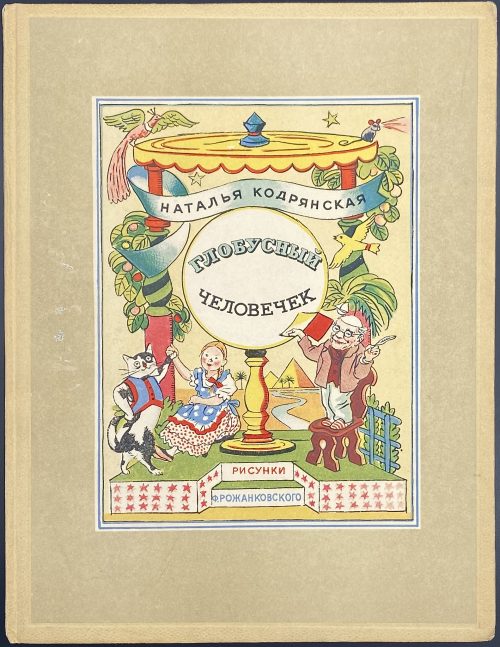 Hardcover volume, 27.8 x 21.4 cm, bound in tan buckram with pictorial paper pasted to front and back boards, brown lettering to spine; pp: fep, [1-6] 7-67 [68] [2] ffl, fep, total 37 leaves; 5 full-page plates, incl. frontispiece (within pagination), covers’ and t.p. vignettes, headpieces, in-text illustrations (eleven in total) chromolithographs after Rojankovsky; the tailpieces are photomechanically reproduced. Title-page (in colour): НАТАЛЬЯ КОДРЯНСКАЯ | ГЛОБУСНЫЙ | ЧЕЛОВЕЧЕК | {vignette} | ИЛЛЮСТРАЦИИ ФЕДОРА РОЖАНКОВСКОГО || Colophon: CET OUVRAGE | A ÉTÉ IMPRIMÉ A PARIS | LA LITHOGRAPHIE | PAR MOURLOT FRÈRES | LA TYPOGRAPHIE | PAR L’IMPRIMERIE UNION | {blank}] | TOUS DROITS RÉSERVÉS POUR PAYS | COPYRIGHT 1954 BY NATALIE CODRAY | Printed in France || Contributors: Наталья Владимировна Кодрянская [Natalie Codray] (Russian-American, 1901 – 1983) – author. Feodor Rojankovsky [Rojan, Фёдор Степанович Рожанковский] (Russian-American, 1891 – 1970) – artist. Mourlot Frères – printer/lithographs. L’imprimerie Union – printer/text.
Hardcover volume, 27.8 x 21.4 cm, bound in tan buckram with pictorial paper pasted to front and back boards, brown lettering to spine; pp: fep, [1-6] 7-67 [68] [2] ffl, fep, total 37 leaves; 5 full-page plates, incl. frontispiece (within pagination), covers’ and t.p. vignettes, headpieces, in-text illustrations (eleven in total) chromolithographs after Rojankovsky; the tailpieces are photomechanically reproduced. Title-page (in colour): НАТАЛЬЯ КОДРЯНСКАЯ | ГЛОБУСНЫЙ | ЧЕЛОВЕЧЕК | {vignette} | ИЛЛЮСТРАЦИИ ФЕДОРА РОЖАНКОВСКОГО || Colophon: CET OUVRAGE | A ÉTÉ IMPRIMÉ A PARIS | LA LITHOGRAPHIE | PAR MOURLOT FRÈRES | LA TYPOGRAPHIE | PAR L’IMPRIMERIE UNION | {blank}] | TOUS DROITS RÉSERVÉS POUR PAYS | COPYRIGHT 1954 BY NATALIE CODRAY | Printed in France || Contributors: Наталья Владимировна Кодрянская [Natalie Codray] (Russian-American, 1901 – 1983) – author. Feodor Rojankovsky [Rojan, Фёдор Степанович Рожанковский] (Russian-American, 1891 – 1970) – artist. Mourlot Frères – printer/lithographs. L’imprimerie Union – printer/text. -
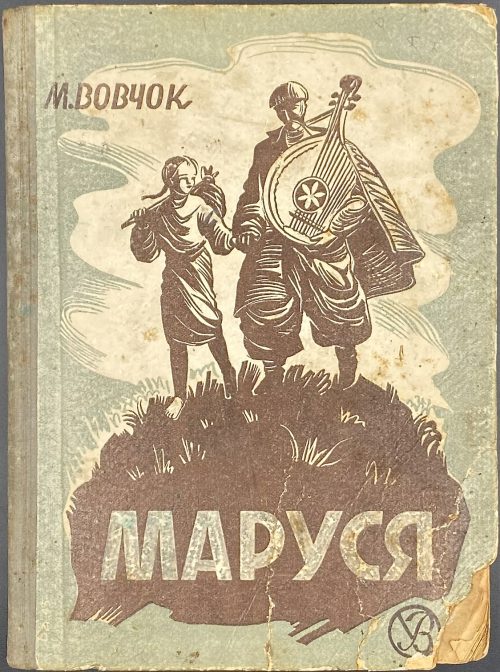 Hardcover, 20.5 x 15.2 cm, pictorial paper over cardboard, cloth-backed; pp.: [1-2] 3-98 [2], last page blank; collated 8vo: 1-58 610; 50 leaves total. Title-page: МАРКО ВОВЧОК | МАРУСЯ | ПОВIСТЬ | УКРАЇНСЬКЕ ВИДАВНИЦТВО | — | КРАКІВ 1943 ЛЬВІВ || Contributors: Марко Вовчок [Marko Vovchok; Марія Олександрівна Вілінська] (Ukrainian, 1833 – 1907) – author. «Українське видавництво» у Кракові-Львові [Verlag: „Ukrainischer Verlag“]– publisher. З друкарні „Поспішної“, Краків, Райхсштрассе 34 [Buchdruck. „Pospieschna“, Krakau, Reichsstrasse 34] – printer. Reichsstrasse (Krakow, Poland) = Ulica Karmelicka (Kraków, Poland). The French version of the Ukrainian name Маруся —> MAROUSSIA. The French version of the book: LIB-2674.2021. Other variants of the author's name Марко Вовчок: Markowovzok and Marko Vovtchok.
Hardcover, 20.5 x 15.2 cm, pictorial paper over cardboard, cloth-backed; pp.: [1-2] 3-98 [2], last page blank; collated 8vo: 1-58 610; 50 leaves total. Title-page: МАРКО ВОВЧОК | МАРУСЯ | ПОВIСТЬ | УКРАЇНСЬКЕ ВИДАВНИЦТВО | — | КРАКІВ 1943 ЛЬВІВ || Contributors: Марко Вовчок [Marko Vovchok; Марія Олександрівна Вілінська] (Ukrainian, 1833 – 1907) – author. «Українське видавництво» у Кракові-Львові [Verlag: „Ukrainischer Verlag“]– publisher. З друкарні „Поспішної“, Краків, Райхсштрассе 34 [Buchdruck. „Pospieschna“, Krakau, Reichsstrasse 34] – printer. Reichsstrasse (Krakow, Poland) = Ulica Karmelicka (Kraków, Poland). The French version of the Ukrainian name Маруся —> MAROUSSIA. The French version of the book: LIB-2674.2021. Other variants of the author's name Марко Вовчок: Markowovzok and Marko Vovtchok. -
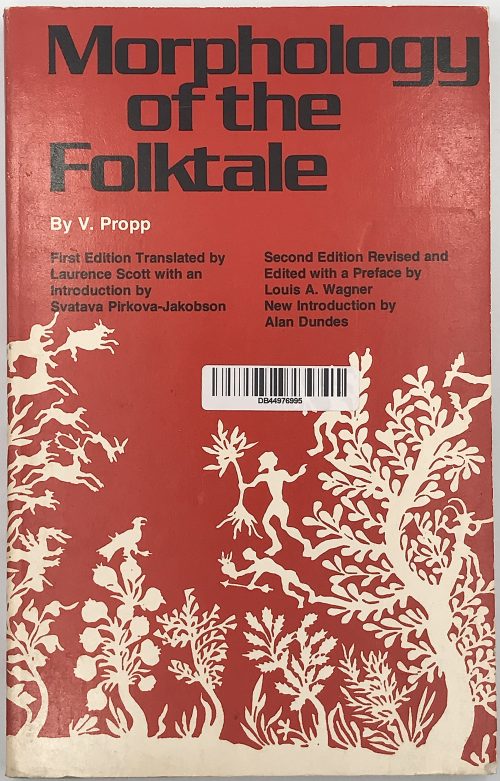 Paperback, 21.5 x 13.6 cm, red and white original wrappers with black lettering, barcode label to front, previous owner’s black ink ms to h.t. Rene Shekerjian; pp.: [i-vii] viii-xxvi[1-3] 4-158 (total 184 pp.). Title-page: Morphology | of the | Folktale | by | V. Propp | First Edition Translated by Lawrence Scott with an Introduction by Svatava Pirkova-Jacobson | Second Edition Revised and Edited with a Preface by Louis A. Warner/New Introduction by Alan Dundes | University of Texas Press • Austin and London || Serial title: American Folklore Society Bibliographical and Special Series | Volume 9/Revised Edition/1968 | [blank] Indiana University Research Center in Anthropology, Folklore, | and Linguistics | Publication 10/Revised Edition/1968 || Edition: 7th paperback printing. Contributors: Владимир Яковлевич Пропп [Vladimir Propp] (Russian, 1895 – 1970) For other editions, see [LIB-1710.2019] В. Я. Пропп. Исторические корни волшебной сказки (2-е изд.) — Л.: Изд-во ЛГУ, 1986; [LIB-3184.2023] В. Я. Пропп. Исторические корни волшебной сказки (1-е изд.) — Л.: Изд-во Ленинградского ун-та, 1946, and [LIB-1718.2019] В. Я. Пропп. Морфология сказки / Серия: Вопросы поэтики, вып. XII. — Л.: Academia, 1928.
Paperback, 21.5 x 13.6 cm, red and white original wrappers with black lettering, barcode label to front, previous owner’s black ink ms to h.t. Rene Shekerjian; pp.: [i-vii] viii-xxvi[1-3] 4-158 (total 184 pp.). Title-page: Morphology | of the | Folktale | by | V. Propp | First Edition Translated by Lawrence Scott with an Introduction by Svatava Pirkova-Jacobson | Second Edition Revised and Edited with a Preface by Louis A. Warner/New Introduction by Alan Dundes | University of Texas Press • Austin and London || Serial title: American Folklore Society Bibliographical and Special Series | Volume 9/Revised Edition/1968 | [blank] Indiana University Research Center in Anthropology, Folklore, | and Linguistics | Publication 10/Revised Edition/1968 || Edition: 7th paperback printing. Contributors: Владимир Яковлевич Пропп [Vladimir Propp] (Russian, 1895 – 1970) For other editions, see [LIB-1710.2019] В. Я. Пропп. Исторические корни волшебной сказки (2-е изд.) — Л.: Изд-во ЛГУ, 1986; [LIB-3184.2023] В. Я. Пропп. Исторические корни волшебной сказки (1-е изд.) — Л.: Изд-во Ленинградского ун-та, 1946, and [LIB-1718.2019] В. Я. Пропп. Морфология сказки / Серия: Вопросы поэтики, вып. XII. — Л.: Academia, 1928. -
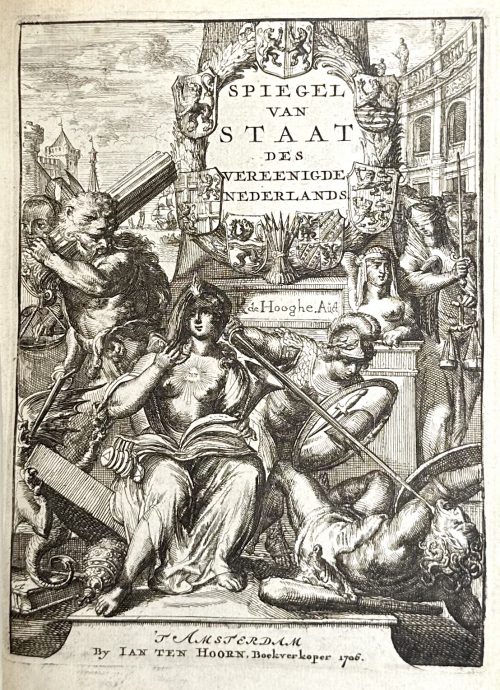 Two hardcover volumes 22.7 x 18.5 x 4.5 cm, uniformly bound in contemporary vellum with a blind border along the edges, handwritten title to spine, printed on laid paper with watermarks to ffls: “Leonard”, “ISRB”, and the arms of Amsterdam. Vol. 1: SPIEGEL van STAAT | des | VEREENIGDE | NEDERLANDS. | Waar in | De Macht en 't Vry Bestier, | Van yder der Zeven Verbonde PROVINCIEN en haar | byzondere Steeden, | Zo in Rechten als Regeeringen werd ontvouwd. | Aanwyzende | Aan, de In, en Uytheemschen, alle de Hooge en Lage Recht- | banken, Collegien en Ampten, dewelke in de zelve, tot | dienst van den Staat, en het Recht, zyn ingesteld. | Hoe, wanneer en waar, voor de zelve yets te verrichten is. | DOOR | Mr: ROMYN de HOOGHE. | EERSTE DEEL: | {fleuron} | t’ AMSTERDAM, | — | By JAN TEN HOORN, Boekverkooper 1706. Collation: 2ffl, *-**4, A-Z4 2A-Z4 3A-O4 4A-G4 5A-S4 6A-F4, 2ffl, (4G2 marked 3G2), total 372 leaves, plus 8 folded leaves of plates, t.p., and half-page vignette dedication by Romeyn de Hooghe. Pagination: [16], 1-267, 268-270 (marked 468-470) 271-480, [2] 3-55 [56], [2] 3-143 [144], [2] 3-44 [4], total 744 pages, ils. Vol. 2: SPIEGEL van STAAT. | VERVATTENDE | DE MACHT DER | GENERALITEYT. | De Edele Mogende Collegiën, | Hooge Rechtbaken, Steden, Schansen | en Onderhoorigheeden, | Welke van Hoog Mogende af angen. | DOOR | Mr: ROMYN de HOOGHE. | TWEEDE DEEL. | Met Figuuren. | {fleuron} | Te AMSTERDAM, | — | By JAN TEN HOORN, | Boekverkooper, 1707. Collation: 2ffl, *-**4, ***2, A-Z4 2A-T4, (A-Z)4, (2A-V)4 X2, 2ffl, total 352 leaves plus 9 folded leaves of plates, t.p., and half-page vignette dedication by Romeyn de Hooghe. Pagination: [20], 1-335 [336], 1-339 [340] [8], total 704 pages, ils. Contributors: Romeyn de Hooghe (Dutch, 1645 – 1708) Jan ten Hoorn (Dutch, fl. 1671 – 1715)
Two hardcover volumes 22.7 x 18.5 x 4.5 cm, uniformly bound in contemporary vellum with a blind border along the edges, handwritten title to spine, printed on laid paper with watermarks to ffls: “Leonard”, “ISRB”, and the arms of Amsterdam. Vol. 1: SPIEGEL van STAAT | des | VEREENIGDE | NEDERLANDS. | Waar in | De Macht en 't Vry Bestier, | Van yder der Zeven Verbonde PROVINCIEN en haar | byzondere Steeden, | Zo in Rechten als Regeeringen werd ontvouwd. | Aanwyzende | Aan, de In, en Uytheemschen, alle de Hooge en Lage Recht- | banken, Collegien en Ampten, dewelke in de zelve, tot | dienst van den Staat, en het Recht, zyn ingesteld. | Hoe, wanneer en waar, voor de zelve yets te verrichten is. | DOOR | Mr: ROMYN de HOOGHE. | EERSTE DEEL: | {fleuron} | t’ AMSTERDAM, | — | By JAN TEN HOORN, Boekverkooper 1706. Collation: 2ffl, *-**4, A-Z4 2A-Z4 3A-O4 4A-G4 5A-S4 6A-F4, 2ffl, (4G2 marked 3G2), total 372 leaves, plus 8 folded leaves of plates, t.p., and half-page vignette dedication by Romeyn de Hooghe. Pagination: [16], 1-267, 268-270 (marked 468-470) 271-480, [2] 3-55 [56], [2] 3-143 [144], [2] 3-44 [4], total 744 pages, ils. Vol. 2: SPIEGEL van STAAT. | VERVATTENDE | DE MACHT DER | GENERALITEYT. | De Edele Mogende Collegiën, | Hooge Rechtbaken, Steden, Schansen | en Onderhoorigheeden, | Welke van Hoog Mogende af angen. | DOOR | Mr: ROMYN de HOOGHE. | TWEEDE DEEL. | Met Figuuren. | {fleuron} | Te AMSTERDAM, | — | By JAN TEN HOORN, | Boekverkooper, 1707. Collation: 2ffl, *-**4, ***2, A-Z4 2A-T4, (A-Z)4, (2A-V)4 X2, 2ffl, total 352 leaves plus 9 folded leaves of plates, t.p., and half-page vignette dedication by Romeyn de Hooghe. Pagination: [20], 1-335 [336], 1-339 [340] [8], total 704 pages, ils. Contributors: Romeyn de Hooghe (Dutch, 1645 – 1708) Jan ten Hoorn (Dutch, fl. 1671 – 1715) -
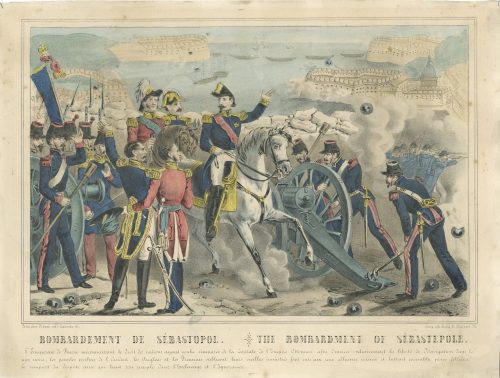 Hand-coloured lithography on wove paper, 250 x 332 mm; black ink stamp “5035” to reverse. Under the frame left: "Paris, chez Riboni, éd. r. Galande, 51"; right: "Paris, lith. Bulla, Pl. Maubert, 26". Below: "BOMBARDEMENT DE SEBASTOPOL. — THE BOMBARDMENT OF SÉBASTOPOLE". Text to bottom. Printers/publishers: Antoine Bulla (fl. 1815 – 1877), François Bulla (fl. c. 1814 – 1855).
Hand-coloured lithography on wove paper, 250 x 332 mm; black ink stamp “5035” to reverse. Under the frame left: "Paris, chez Riboni, éd. r. Galande, 51"; right: "Paris, lith. Bulla, Pl. Maubert, 26". Below: "BOMBARDEMENT DE SEBASTOPOL. — THE BOMBARDMENT OF SÉBASTOPOLE". Text to bottom. Printers/publishers: Antoine Bulla (fl. 1815 – 1877), François Bulla (fl. c. 1814 – 1855). -
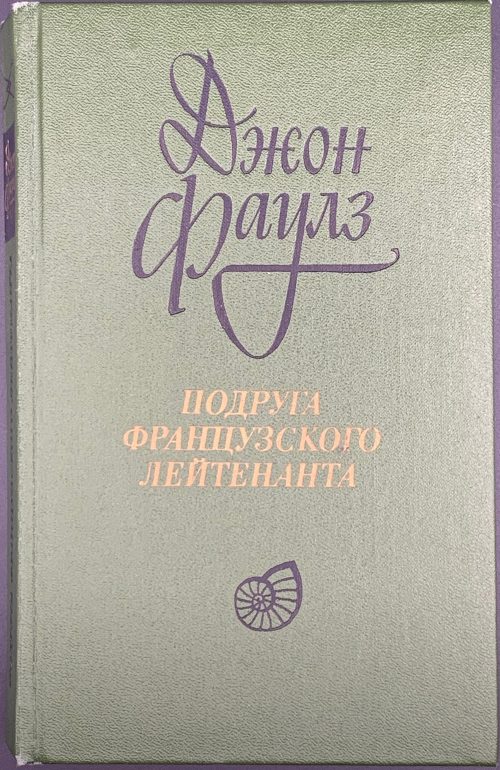 Hardcover, 20.8 x 13.2 cm; publisher's original green cloth with black and gilt lettering to front and spine; pictorial endpapers. Gift ms inscription from Irina Komarova to Yury and Elvina Varshavsky to front free endpaper's verso: "Прослышав, что теперь для Юры / Нет ничего милей гравюры, / Литературу я отныне / Дарю из принципа Эльвине! / И. / Февраль 86". Pp.: [2] 3-477 [3], collation 16mo: 1-1516 (total 240 leaves) plus portrait frontispiece. Title-page: Джон Фаулз | ПОДРУГА | ФРАНЦУЗСКОГО | ЛЕЙТЕНАНТА | РОМАН | Перевод с английского | М. Беккер и И. Комаровой | под редакцией Н. Рахмановой | {vignette} | {publisher’s device} | ЛЕНИНГРАД | «ХУДОЖЕСТВЕННАЯ ЛИТЕРАТУРА» | ЛЕНИНГРАДСКОЕ ОТДЕЛЕНИЕ• 1985 || T.p. verso: […] | JOHN FOWLES | THE FRENCH LIEUTENANT'S WOMAN | Вступительная статья А. ДОЛИНИНА | Примечания М. БЕККЕР | Оформление художников | Н. ВАСИЛЬЕВА и Э. КАПЕЛЮША | […] || Contributors: Беккер, Мэри Иосифовна (Russian, 1920 – 2010) Комарова, Ирина Бенедиктовна (Russian, b. 1933) Рахманова, Наталия Леонидовна (Russian, b. 1930)
Hardcover, 20.8 x 13.2 cm; publisher's original green cloth with black and gilt lettering to front and spine; pictorial endpapers. Gift ms inscription from Irina Komarova to Yury and Elvina Varshavsky to front free endpaper's verso: "Прослышав, что теперь для Юры / Нет ничего милей гравюры, / Литературу я отныне / Дарю из принципа Эльвине! / И. / Февраль 86". Pp.: [2] 3-477 [3], collation 16mo: 1-1516 (total 240 leaves) plus portrait frontispiece. Title-page: Джон Фаулз | ПОДРУГА | ФРАНЦУЗСКОГО | ЛЕЙТЕНАНТА | РОМАН | Перевод с английского | М. Беккер и И. Комаровой | под редакцией Н. Рахмановой | {vignette} | {publisher’s device} | ЛЕНИНГРАД | «ХУДОЖЕСТВЕННАЯ ЛИТЕРАТУРА» | ЛЕНИНГРАДСКОЕ ОТДЕЛЕНИЕ• 1985 || T.p. verso: […] | JOHN FOWLES | THE FRENCH LIEUTENANT'S WOMAN | Вступительная статья А. ДОЛИНИНА | Примечания М. БЕККЕР | Оформление художников | Н. ВАСИЛЬЕВА и Э. КАПЕЛЮША | […] || Contributors: Беккер, Мэри Иосифовна (Russian, 1920 – 2010) Комарова, Ирина Бенедиктовна (Russian, b. 1933) Рахманова, Наталия Леонидовна (Russian, b. 1930) -
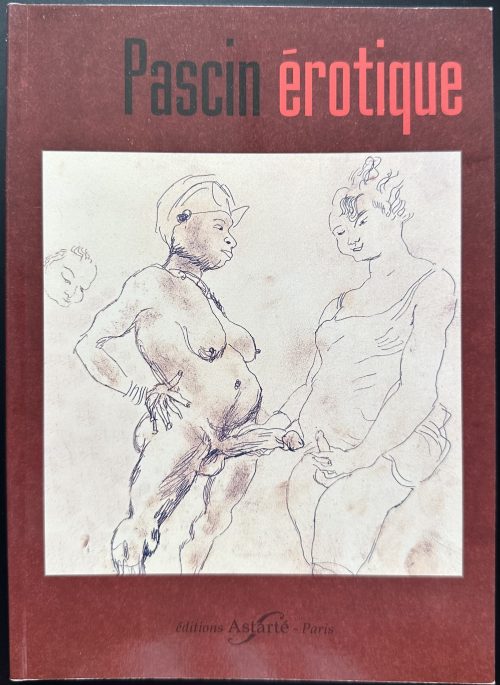 Catalogue raisonné of Pascin's erotic drawings. Softcover, 21 x 15 cm, burgundy gloss pictorial paperback with lettering and vignettes, pp.: [1-3] 4-102 [2], illustrated throughout. Limited edition of 1,000 copies. Title-page: Pascin érotique | {round vignette} | éditions Astarté - Paris || Contributors: Alexandre Dupouy (French) Pascin, Jules [Pincas, Julius Mordecai] (French-Jewish, 1885 – 1930)
Catalogue raisonné of Pascin's erotic drawings. Softcover, 21 x 15 cm, burgundy gloss pictorial paperback with lettering and vignettes, pp.: [1-3] 4-102 [2], illustrated throughout. Limited edition of 1,000 copies. Title-page: Pascin érotique | {round vignette} | éditions Astarté - Paris || Contributors: Alexandre Dupouy (French) Pascin, Jules [Pincas, Julius Mordecai] (French-Jewish, 1885 – 1930) -
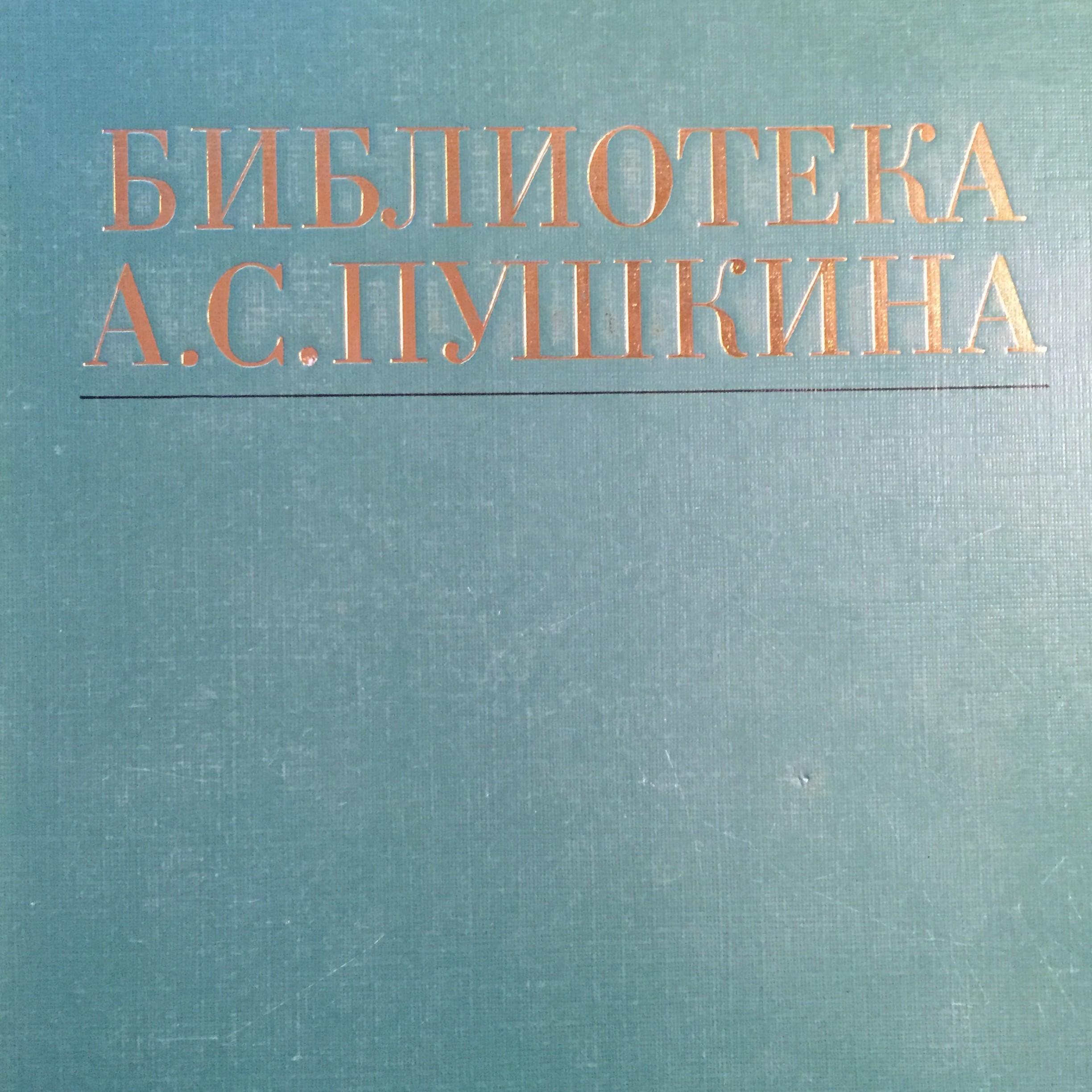
Б. Л. Модзалевский. Библиотека А.С.Пушкина. Библиографическое описание. Отдѣльный оттискъ из изданiя "Пушкинъ и его современники", вып. IX-X. -- СПб.: Тип. Императорской Академiи Наук, 1910. - 442 стр. [РЕПРИНТ 1988 года.]
Библиотека А. С. Пушкина. Б. Л. Модзалевский. Приложение к репринтному изданию. -- М.: Книга, 1988. - 115 стр. Тираж 10 000 экз.
Л. Б. Модзалевский. Библиотека Пушкина. Новые материалы.
Список условных сокращений.
Л. С. Сидяков. Библиотека Пушкина и ее описание.
Примечание к работам Б. Л. и Л. Б. Модзалевских.
-
 Fuchi-kashira of copper, carved and inlaid with gold and shakudō, with the design of Kanzan (on kashira), Chinese: Hanshan, an eccentric poet of the Tang dynasty with a scroll (618-906) who befriended Jittoku (on fuchi, Chinese: Shide, a kitchen helper at a mountain temple, holding a broom). Fuchi is signed Josui (如⽔). Fuchi (Jittoku, holding a broom): 38 x 22 x 12 mm. Weight: 23g (Nakago hole: 27 x 8.5 mm); Kashira (Kanzan, reading a scroll): 34 x 17 x 9 mm. Weight: 10g. Materials: Copper, gold, shakudō. Techniques: Tsuchi-me-ji (hammer-marked surface); usu-shishiai-bori or usuniku-bori (low-relief carving which leaves the image somewhat higher than the surface - high relief effect); zōgan (inlay). Josui was a daughter of Jochiku Kamo (Markus Sesko, Genealogies).
Fuchi-kashira of copper, carved and inlaid with gold and shakudō, with the design of Kanzan (on kashira), Chinese: Hanshan, an eccentric poet of the Tang dynasty with a scroll (618-906) who befriended Jittoku (on fuchi, Chinese: Shide, a kitchen helper at a mountain temple, holding a broom). Fuchi is signed Josui (如⽔). Fuchi (Jittoku, holding a broom): 38 x 22 x 12 mm. Weight: 23g (Nakago hole: 27 x 8.5 mm); Kashira (Kanzan, reading a scroll): 34 x 17 x 9 mm. Weight: 10g. Materials: Copper, gold, shakudō. Techniques: Tsuchi-me-ji (hammer-marked surface); usu-shishiai-bori or usuniku-bori (low-relief carving which leaves the image somewhat higher than the surface - high relief effect); zōgan (inlay). Josui was a daughter of Jochiku Kamo (Markus Sesko, Genealogies). -
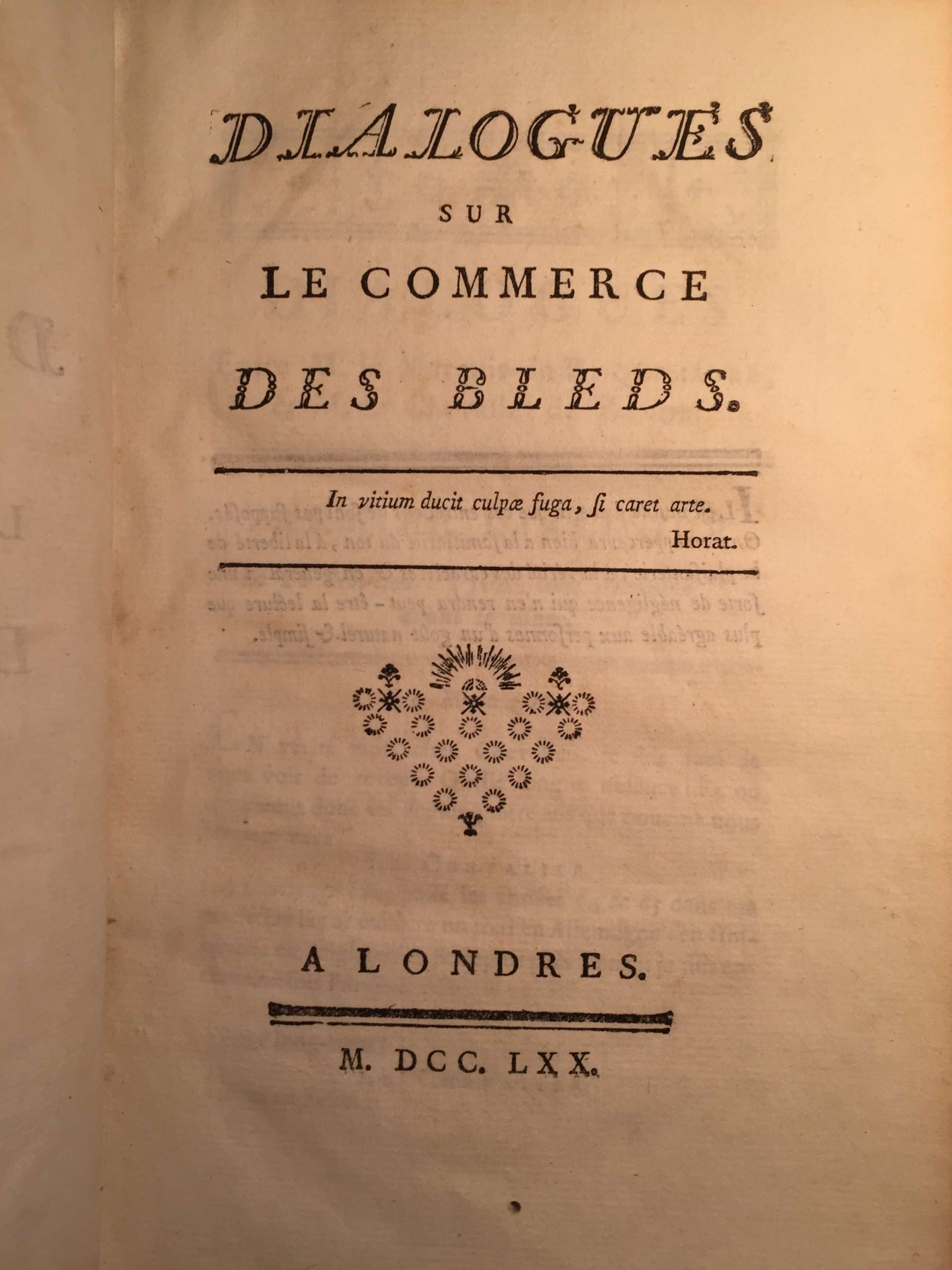
GALIANI, Ferdinando, Abbé. Dialogue sur le commerce des bleds. Londres, 1770. L'Abbé Roubaud, Pierre Joseph André. Récréations économiques ou lettres de l'auteur des représentations aux magistrats, a M. le chevalier Zanobi, principal interlocuteur des Dialogues sur le commerce des bleds; Amsterdam & Paris, Delalain, 1770. Béguillet, Edme. De principiis vegetationis et agreculturae et de causis triplicis culturae in Burgundia disquisitio physica. Auctore E.B.D. ex Societate Œconomica Lugdunensi; Divione, 1768.
-
 Iron tsuba of slightly elongated round form with design of wild geese and drops on pampas grass (masashino) in openwork (sukashi). Rounded rim. Copper sekigane. Owari school. Early Edo period: early 17th century (Kan-ei era). Height: 78.8 mm. Width: 76.3 mm. Rim thickness: 6.1 mm. Center thickness: 6.4 mm. Provenance: Sasano Masayuki Collection, № 169. A description of musashino symbolism can be found at Symbols of Japan by Merrily Baird [Merrily Baird. Symbols of Japan. Thematic motifs in art and design. Rizzoli international publications, Inc., 2001]: Musashino - "the plain of Musashi - a large expanse in the Tokyo area, was celebrated in poetry for the grasses that grew there before the recent era of industrialization... The use of Musashino themes was particularly common in the Momoyama and Edo periods". Pampas grass with dew drops and wild geese in flight collectively provide strong autumnal connotation.
Iron tsuba of slightly elongated round form with design of wild geese and drops on pampas grass (masashino) in openwork (sukashi). Rounded rim. Copper sekigane. Owari school. Early Edo period: early 17th century (Kan-ei era). Height: 78.8 mm. Width: 76.3 mm. Rim thickness: 6.1 mm. Center thickness: 6.4 mm. Provenance: Sasano Masayuki Collection, № 169. A description of musashino symbolism can be found at Symbols of Japan by Merrily Baird [Merrily Baird. Symbols of Japan. Thematic motifs in art and design. Rizzoli international publications, Inc., 2001]: Musashino - "the plain of Musashi - a large expanse in the Tokyo area, was celebrated in poetry for the grasses that grew there before the recent era of industrialization... The use of Musashino themes was particularly common in the Momoyama and Edo periods". Pampas grass with dew drops and wild geese in flight collectively provide strong autumnal connotation. -
 Iron tsuba of round form with two ebi (lobster) on omote (obverse side) and shika (deer) among scattered momiji (maple leaves) on ura (reverse side) motif in brass takabori (high relief) suemon-zōgan. Traces of lacquer. Unsigned. Late Muromachi / Momoyama period (late 16th / Early 17th century). Dimensions: 69.0.6 mm (H) x 69.6 mm (W) x 3.4 mm (T, seppa-dai). Weight: 92.6 g. Illustrated at: The Lundgren Collection of Japanese Swords, Sword Fittings and A Group of Miochin School Metalwork. Christie's Auction: Tuesday, 18 November 1997, London. Sales "GOTO-5881". Christie's, 1997. - #2 at page 7. Provenance: The second John Harding; The Lundgren Collection. Description at Christie's: "The iron plate depicting two lobsters in takabory and brass takazogan, the reverse similarly decorated with deer among scattered maple leaves, square mimi, late Muromachi / early Momoyama period (late 16th/early 17th century) Diameter 68 mm, mimi thickness 4 mm. Provenance: The second John Harding." Also at: JAPANESE SWORD-FITTINGS & METALWORK IN THE LUNDGREN COLLECTION. Published by Otsuka Kogeisha, Tokyo 1992. № 134. Description on page 173: Sword guard with design of shrimps in inlay (scarlet [sic] maple leaves and deer on the reverse side). Unsigned. Heianjō inlay school. Vertical 6.85 cm, horizontal 6.90 cm, Th. of rim 0.40 cm. Iron. Taka-bori relief and brass inlay. Momoyama period, 16th - 17th century. According to Merrily Baird, maple leaves, especially if paired with the deer, allude to autumnal tradition of Japanese aristocracy of viewing the seasonal changes of color in the Nara area. The lobster is typical Japanese ebi, - it lacks prominent claws, and has a spiny shell. As a symbol of longevity and good fortune, lobster is a staple of New Year's decoration.
Iron tsuba of round form with two ebi (lobster) on omote (obverse side) and shika (deer) among scattered momiji (maple leaves) on ura (reverse side) motif in brass takabori (high relief) suemon-zōgan. Traces of lacquer. Unsigned. Late Muromachi / Momoyama period (late 16th / Early 17th century). Dimensions: 69.0.6 mm (H) x 69.6 mm (W) x 3.4 mm (T, seppa-dai). Weight: 92.6 g. Illustrated at: The Lundgren Collection of Japanese Swords, Sword Fittings and A Group of Miochin School Metalwork. Christie's Auction: Tuesday, 18 November 1997, London. Sales "GOTO-5881". Christie's, 1997. - #2 at page 7. Provenance: The second John Harding; The Lundgren Collection. Description at Christie's: "The iron plate depicting two lobsters in takabory and brass takazogan, the reverse similarly decorated with deer among scattered maple leaves, square mimi, late Muromachi / early Momoyama period (late 16th/early 17th century) Diameter 68 mm, mimi thickness 4 mm. Provenance: The second John Harding." Also at: JAPANESE SWORD-FITTINGS & METALWORK IN THE LUNDGREN COLLECTION. Published by Otsuka Kogeisha, Tokyo 1992. № 134. Description on page 173: Sword guard with design of shrimps in inlay (scarlet [sic] maple leaves and deer on the reverse side). Unsigned. Heianjō inlay school. Vertical 6.85 cm, horizontal 6.90 cm, Th. of rim 0.40 cm. Iron. Taka-bori relief and brass inlay. Momoyama period, 16th - 17th century. According to Merrily Baird, maple leaves, especially if paired with the deer, allude to autumnal tradition of Japanese aristocracy of viewing the seasonal changes of color in the Nara area. The lobster is typical Japanese ebi, - it lacks prominent claws, and has a spiny shell. As a symbol of longevity and good fortune, lobster is a staple of New Year's decoration. -

-
 Katsukawa Shun'ei. Signed: Shun'ei ga (春英画). Vertical Ōban. No reference whatsoever. Unidentified play, actors, roles, year, theatre. SOLD
Katsukawa Shun'ei. Signed: Shun'ei ga (春英画). Vertical Ōban. No reference whatsoever. Unidentified play, actors, roles, year, theatre. SOLD -
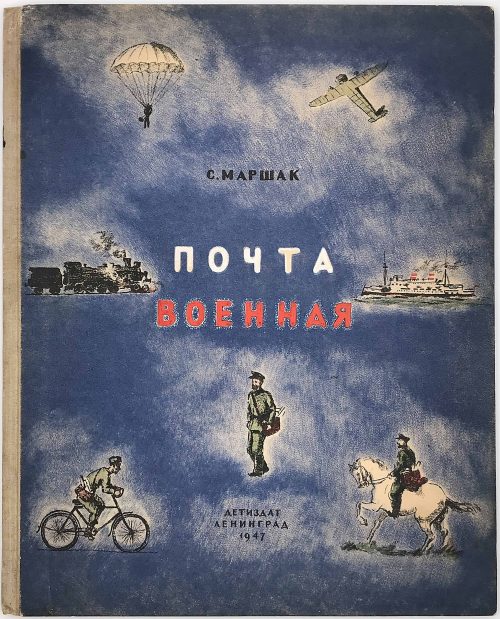 С. Маршак. Почта военная. Детиздат : Ленинград, 1947.
С. Маршак. Почта военная. Детиздат : Ленинград, 1947.Hard-bound Quatro (304 x 246 mm) printed in lithography with hand-colored details on cover.
The name of artist hardly legible on a stamp on frontispiece: скворцов.
The text repeats itself on multiple pages. Most probably the book is a pilot run, never went to mass printing and distribution. -
 Iron tsuba of six-lobed (mutsu-mokkō-gata) form, with six wild boar's eye shape (inome) openings (sukashi). Ryo-Hitsu and the entire perimeter of tsuba have typical for this school raised rim; raised seppa dai. Lobes are decorated in low relief carving (sukidashi-bori). On the obverse: chrysanthemum, Genji mon, waves and rocks, grasses and star, bellflower, star and flower in tortoiseshell (kikko). On the reverse: Stars and different flowers, and flying geese. The plate is damaged to the left of nakago-ana and around the left hitsu-ana. Kamakura-bori school. Late Muromachi period (1514-1573). Diameter: 89 mm; Thickness at seppa-dai: 4.0 mm; Weight: 108.8 g [large]. There is a similar tsuba in this collection, TSU-0345.2018, but with a different motif and much smaller: diameter 74.3 mm, thickness at seppa-dai: 3.2 mm, weight: 62.8 g.Another look-a-like tsuba can be found at the Compton Collection, part II, pp. 14-15, №17, though his tsuba is more massive (80 x 84 x 4 mm).
Iron tsuba of six-lobed (mutsu-mokkō-gata) form, with six wild boar's eye shape (inome) openings (sukashi). Ryo-Hitsu and the entire perimeter of tsuba have typical for this school raised rim; raised seppa dai. Lobes are decorated in low relief carving (sukidashi-bori). On the obverse: chrysanthemum, Genji mon, waves and rocks, grasses and star, bellflower, star and flower in tortoiseshell (kikko). On the reverse: Stars and different flowers, and flying geese. The plate is damaged to the left of nakago-ana and around the left hitsu-ana. Kamakura-bori school. Late Muromachi period (1514-1573). Diameter: 89 mm; Thickness at seppa-dai: 4.0 mm; Weight: 108.8 g [large]. There is a similar tsuba in this collection, TSU-0345.2018, but with a different motif and much smaller: diameter 74.3 mm, thickness at seppa-dai: 3.2 mm, weight: 62.8 g.Another look-a-like tsuba can be found at the Compton Collection, part II, pp. 14-15, №17, though his tsuba is more massive (80 x 84 x 4 mm).
Varshavsky Collection: TSU-0345.2018
This tsuba, TSU-0401.2019, is the biggest of all three (another mine and the one from Campton Collection). The presence of a flower in a tortoiseshell symbol (crest or mon) on this tsuba alludes to Izumo Shrine. The overall piece, with symbols of grasses, waves, flowers, incense, stars, and flying geese, is full of autumnal connotations.
Compton Collection, part II, pp. 14-15, №17: Kamakura-bori tsuba, ca. 1450.
-
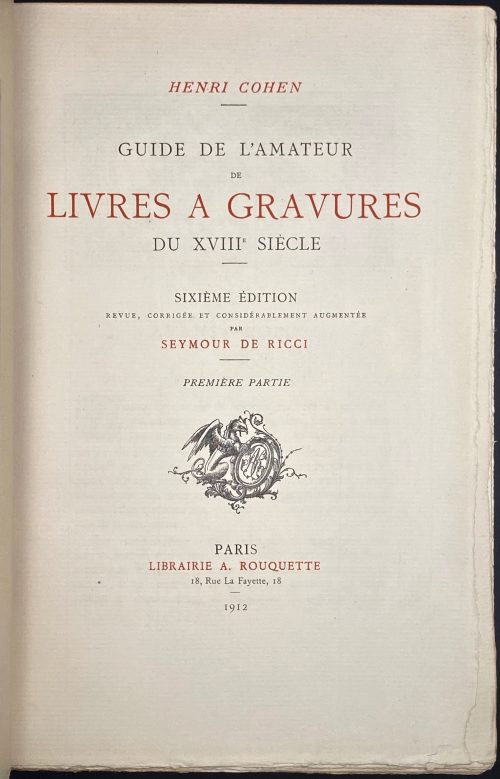 Herni Cohen. Guide de l'amateur de livres à gravures du XVIIIe siècle (6e édition) / Revue, corrigée et considérablement augmentée par Seymour de Ricci, préface par R. Portalis; 2 Volumes. – Paris: Librairie A. Rouquette, 1912. – Achevé d'Imprimer à Melun par Émile Legrand le 25 juin MDCCCCXII [1912]. Vol. 1, Première partie – ABAA-LUY: ffl [4 blanks] [2 - orig. grey front wrapper w/title, verso blank] [2 blanks] [2 - ht, tirage] [2 - blank, frontis. w/protect. sheet] [2 - blank, frontis. w/protect. sheet] (double frontis. - correct), [2 - t.p., blank] [i - avant-propos w/vignette] ii-vi, [vii - préface w/vignette] viii-xxvi; [1-2 - Tome 1, I] 2-668 (two numbers per page), [2 - fin, blank] [2 blanks] [2 - orig. grey back wrapper, recto blank] [orig. spine strip] [4 blanks] bfl. Vol. 2, Seconde partie – MAB-ZUR : ffl [4 blanks] [2 - orig. grey front wrapper w/title, verso blank] [2 blanks] [2 - ht, blank] [2 - t.p., blank] [2 - blank, frontis. w/protect. sheet] [2 - blank, frontis. w/protect. sheet] (double frontis. - correct), [1-2 - Tome II, 22] 671-1248 (two numbers per page), [2 - printer, blank] [2 blanks] [2 - orig. grey back wrapper, recto imprim.] [orig. spine strip] [4 blanks] bfl. Size: Super Royal 8vo, 26.2 x 17.2 x 5.1 cm. Binding: Contemporary blue half morocco over marbled boards, marbled end-papers, top margin gilt, gilt lettering to spine (title, owner: P. R.).; bookplate pasted to verso of the first blank leaf: " Ex Libris R. Decamps Scrive." – for bibliophile René Descamps-Scrive (French, 1853 –1924). Original wrappers preserved. Printed on Hollande paper, copy № 2 of the first 50; total print-run 1050 copies. Catalogue raisonné of French illustrated books of the 18th century.
Herni Cohen. Guide de l'amateur de livres à gravures du XVIIIe siècle (6e édition) / Revue, corrigée et considérablement augmentée par Seymour de Ricci, préface par R. Portalis; 2 Volumes. – Paris: Librairie A. Rouquette, 1912. – Achevé d'Imprimer à Melun par Émile Legrand le 25 juin MDCCCCXII [1912]. Vol. 1, Première partie – ABAA-LUY: ffl [4 blanks] [2 - orig. grey front wrapper w/title, verso blank] [2 blanks] [2 - ht, tirage] [2 - blank, frontis. w/protect. sheet] [2 - blank, frontis. w/protect. sheet] (double frontis. - correct), [2 - t.p., blank] [i - avant-propos w/vignette] ii-vi, [vii - préface w/vignette] viii-xxvi; [1-2 - Tome 1, I] 2-668 (two numbers per page), [2 - fin, blank] [2 blanks] [2 - orig. grey back wrapper, recto blank] [orig. spine strip] [4 blanks] bfl. Vol. 2, Seconde partie – MAB-ZUR : ffl [4 blanks] [2 - orig. grey front wrapper w/title, verso blank] [2 blanks] [2 - ht, blank] [2 - t.p., blank] [2 - blank, frontis. w/protect. sheet] [2 - blank, frontis. w/protect. sheet] (double frontis. - correct), [1-2 - Tome II, 22] 671-1248 (two numbers per page), [2 - printer, blank] [2 blanks] [2 - orig. grey back wrapper, recto imprim.] [orig. spine strip] [4 blanks] bfl. Size: Super Royal 8vo, 26.2 x 17.2 x 5.1 cm. Binding: Contemporary blue half morocco over marbled boards, marbled end-papers, top margin gilt, gilt lettering to spine (title, owner: P. R.).; bookplate pasted to verso of the first blank leaf: " Ex Libris R. Decamps Scrive." – for bibliophile René Descamps-Scrive (French, 1853 –1924). Original wrappers preserved. Printed on Hollande paper, copy № 2 of the first 50; total print-run 1050 copies. Catalogue raisonné of French illustrated books of the 18th century.





